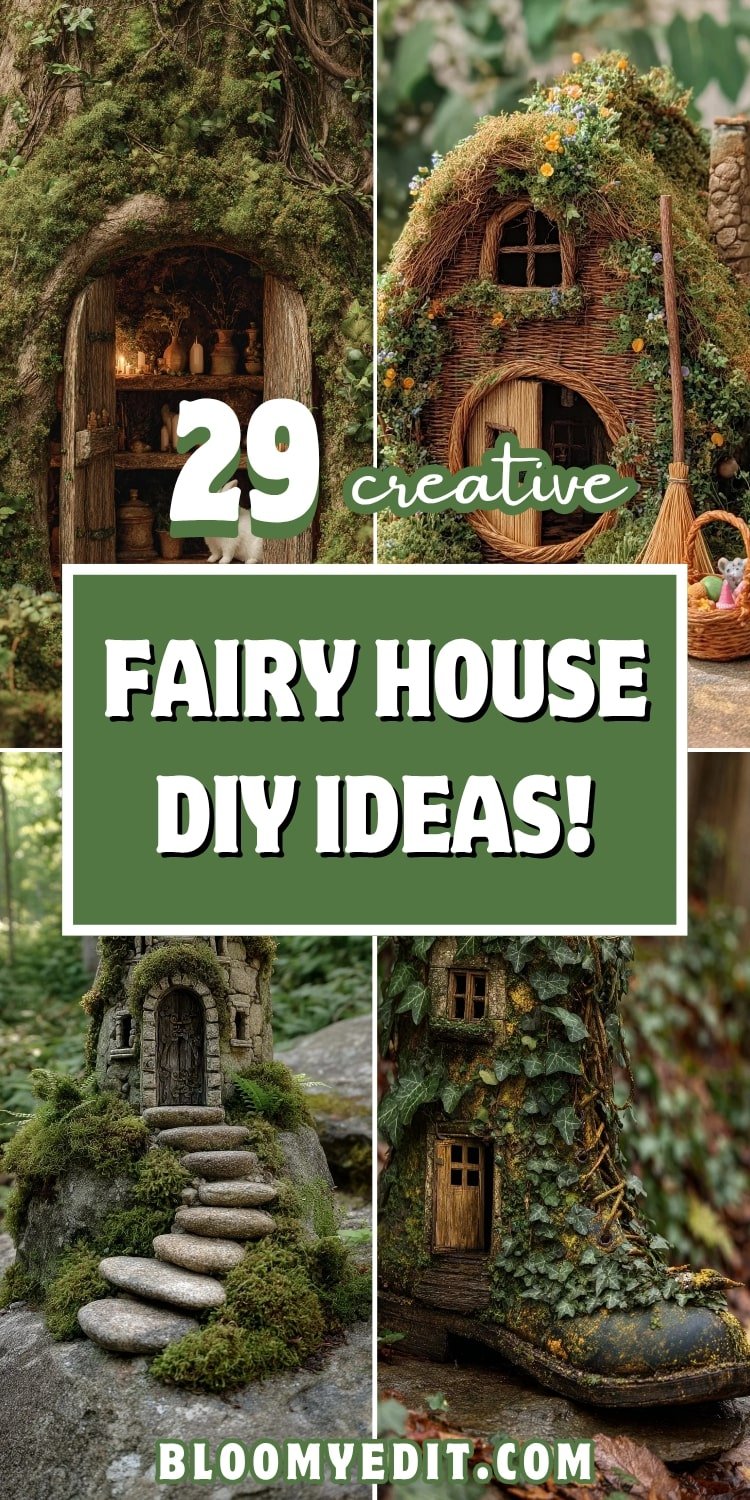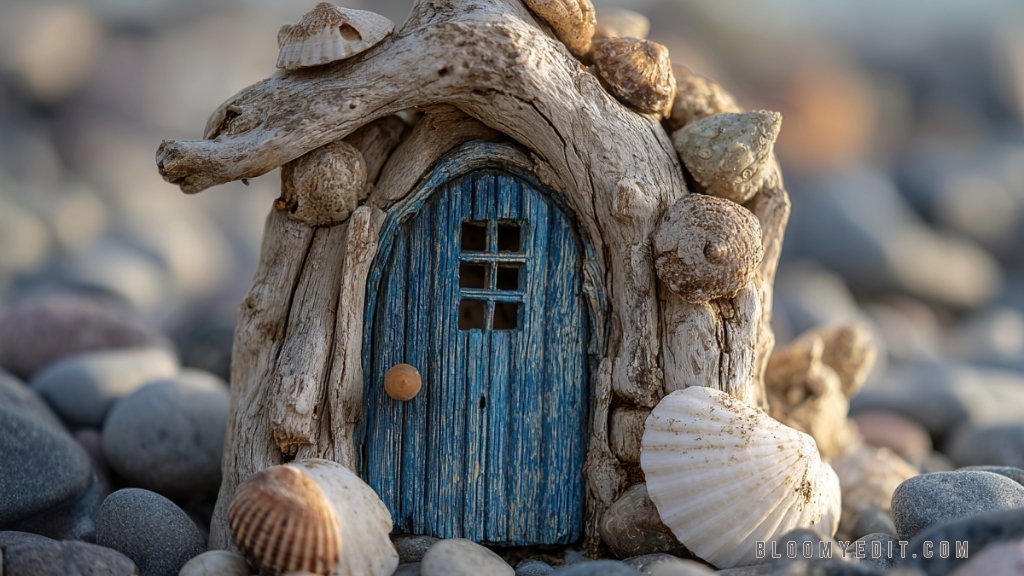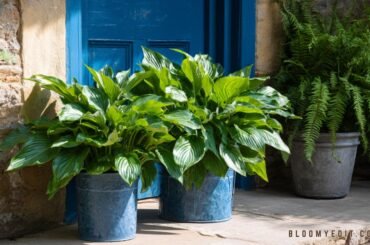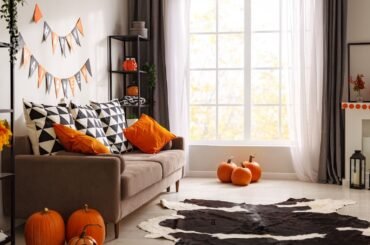You’re walking through the garden, coffee in hand, when your eyes catch a gnarled tree root or a mossy corner, and just for a second, it feels like something magical could live there. A tiny door tucked into the bark.
A pebble path leading to nowhere. Maybe you’ve seen it in a child’s wide-eyed stare or felt it in that quiet pull to make something just because it brings joy.
Fairy houses aren’t about perfection or Pinterest-worthy photos. They’re about wonder. About using twigs, shells, bottle caps, whatever you’ve got, to build a world that feels alive in miniature.
Whether you’re crafting with kids, adding charm to your backyard, or just letting your creativity play, there’s something grounding and oddly comforting about making tiny magic with your hands.
The best part? There’s no right way to do it. Just small-scale creativity, a little nature, and a lot of heart.
Ahead, you’ll find 29 Fairy House DIY Ideas that spark that childlike spark again, simple, imaginative, and wildly charming ways to build a fairy house that feels like it came straight out of a storybook.
1. Miniature Bedroom into a Storybook Base
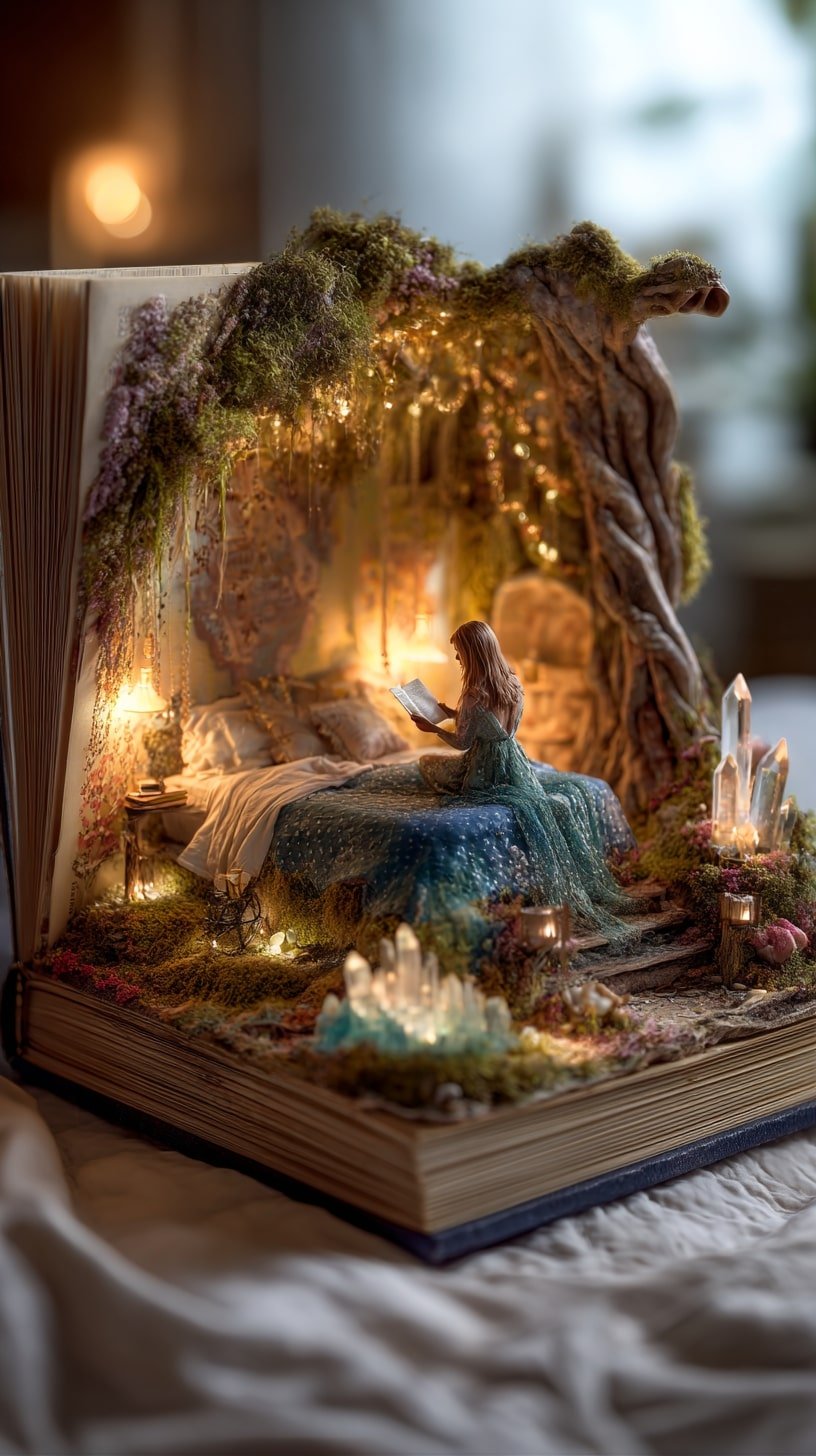
Literal magic. An open book becomes foundation and frame, its pages cradling mossy ground and a glittering canopy of twinkle lights.
The bed, textured in velvet and gauze, anchors the scene. Small, yes. But rich. Layering is key. Crystal clusters glow from below. Tree roots twist into walls.
Lighting defines scale and space. Every corner tells a story, even before she opens her book.
2. Old Boot into a Moss-Covered Fairy Hideaway
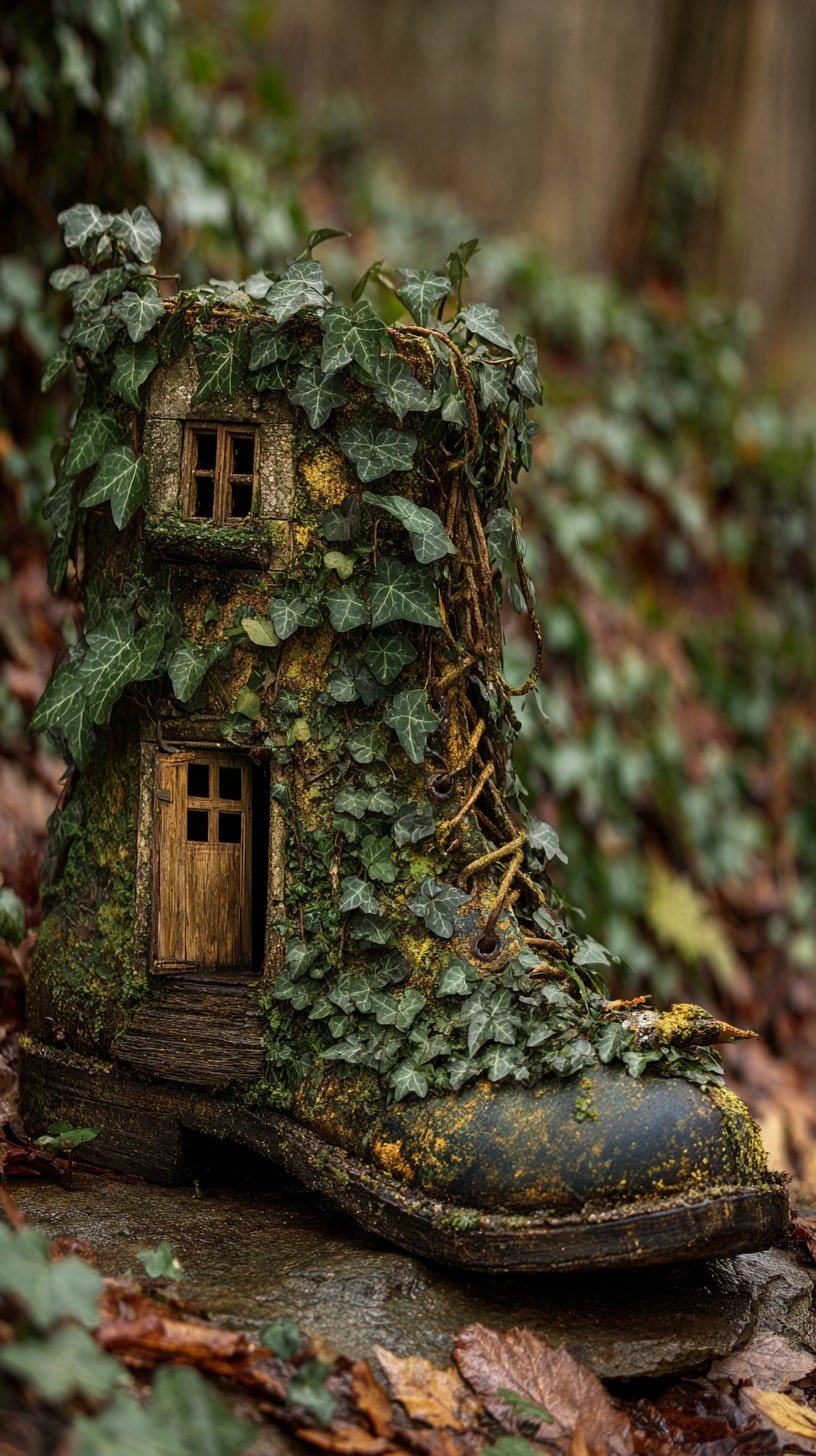
An aged boot forms a ready-made structure , rigid, weatherproof, full of quirks. Ivy climbs naturally, hiding seams, softening shape.
Tiny wood-frame windows punch through the leather, giving it soul. Use real moss for depth. Let vines take over. Scale stays believable when doors and details sit low.
A storybook home, no plastic needed.
3. Round Door into a Wicker Fairy Cottage
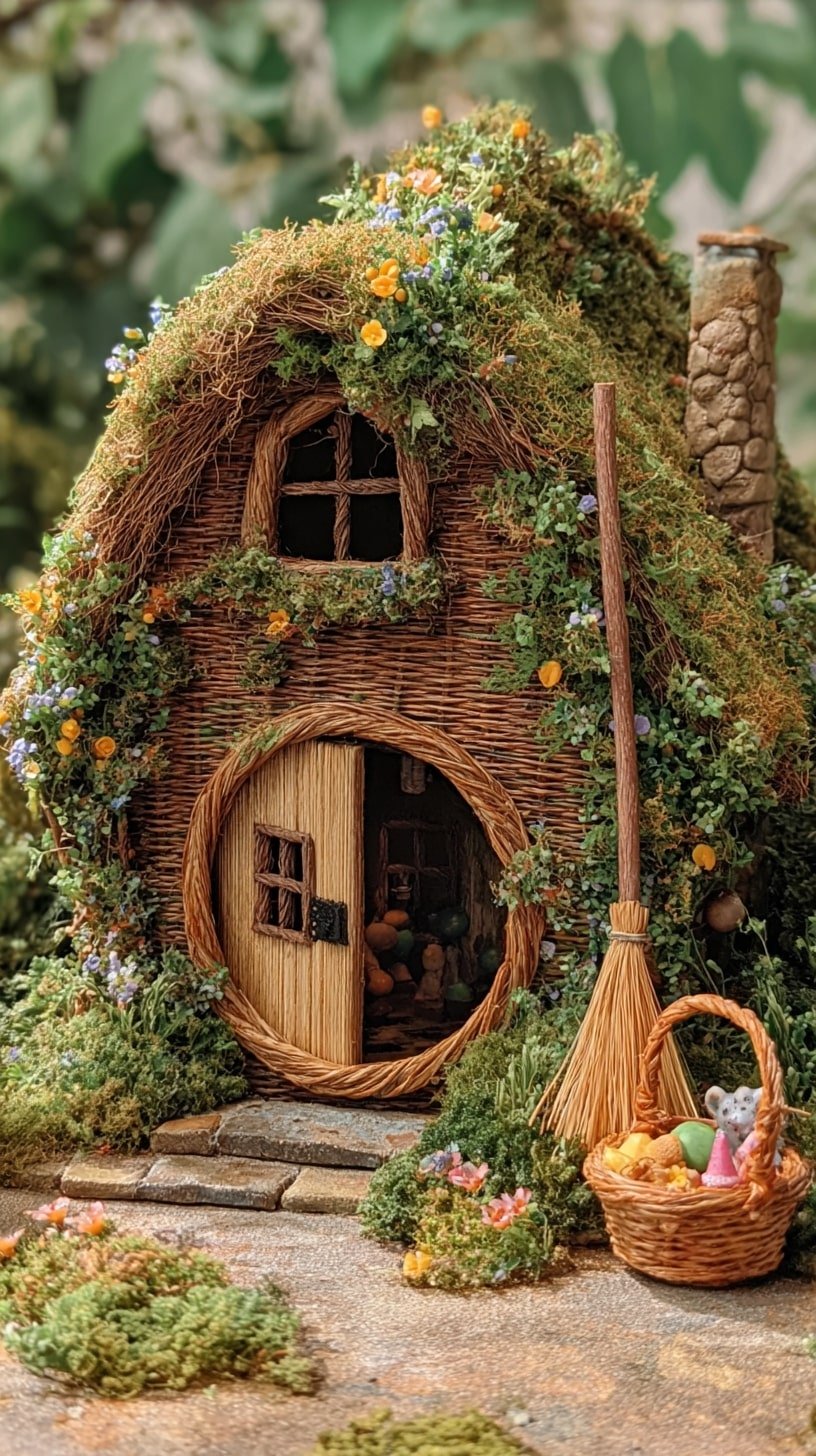
Twisted vine and rattan give this house backbone , lightweight but strong. The round door sets a soft tone, while stacked stone steps add grounding.
Flowers tumble over the mossy roof like a thatched garden quilt. Texture everywhere. No flat surfaces. Use floral wire to hold curves.
Tuck tiny florals into woven gaps. Let form follow fantasy.
4. Hollow Nook into a Mossy Tree Trunk
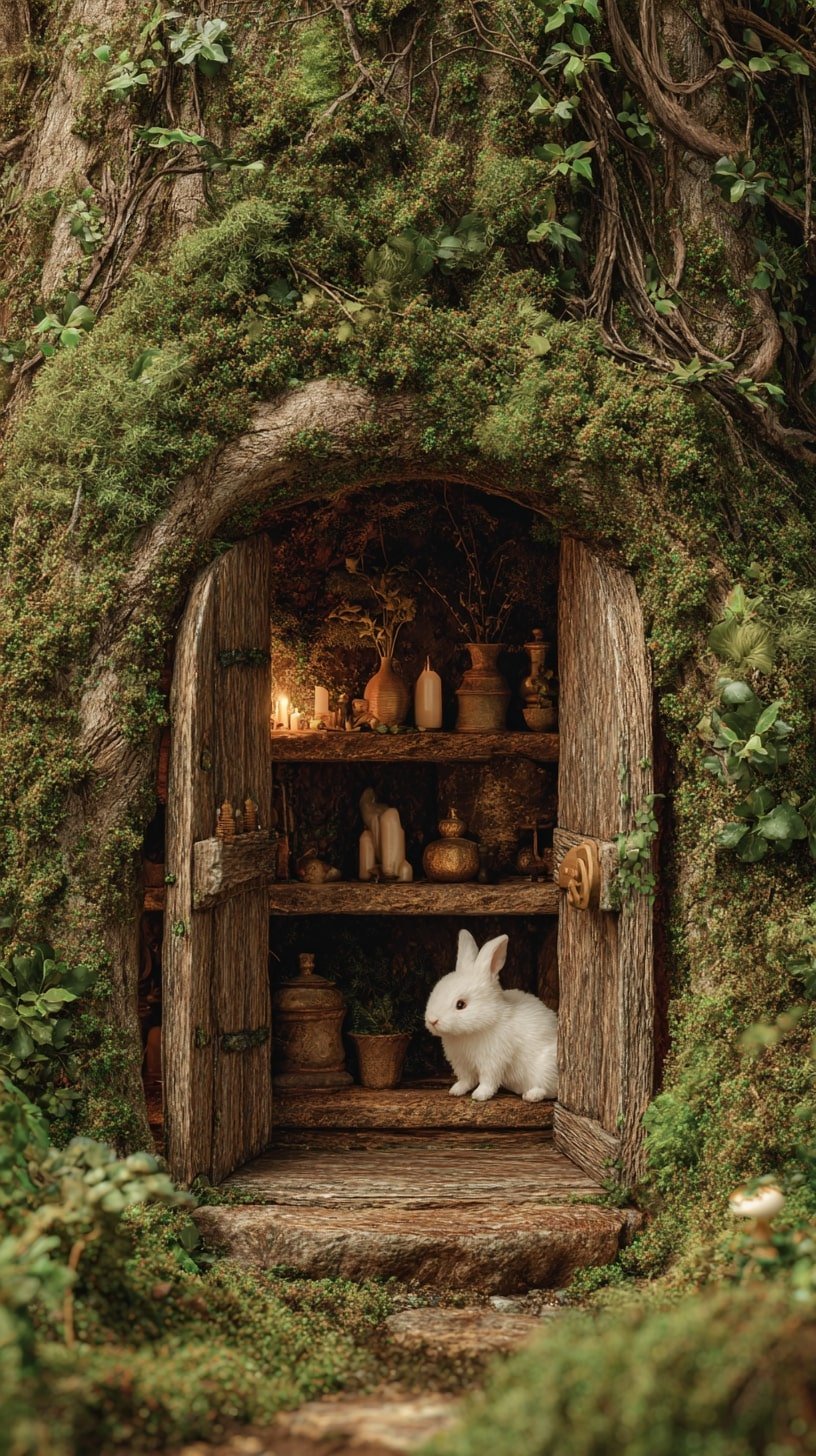
Go sculptural. Using a real or faux log, hollow just enough space to cradle a rustic shelf setup. Wood grain stays rough. That’s key.
Candlelight flickers off old glass, casting soft shadows. Every item feels hand-gathered. Let moss spill freely.
Vines can twist up around door edges. Keep materials aged, uneven, just a little wild. Adds soul.
5. Tower House with a Floral Canopy and Glowing Windows
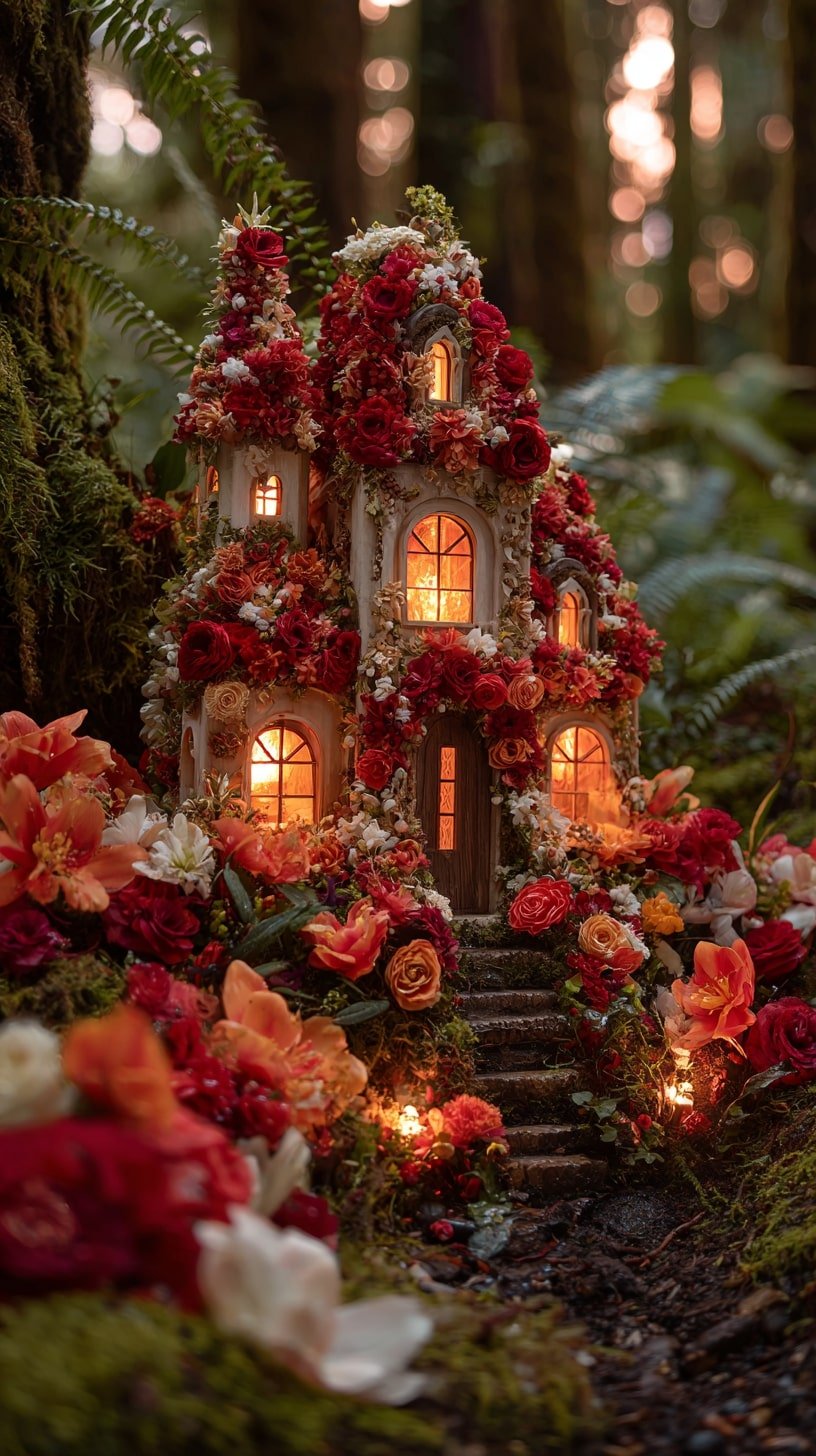
DIY fairy manor breaks scale rules , and it works. Layered florals climb every turret, thick and bursting. Texture is rich, dense.
All real petals? Not necessary. Mix silk and dried blooms for longevity. Backlight every window.
That amber glow anchors it. Stairs feel ceremonial, almost royal.
6. Coastal Cottage with Driftwood and Shell Shingles
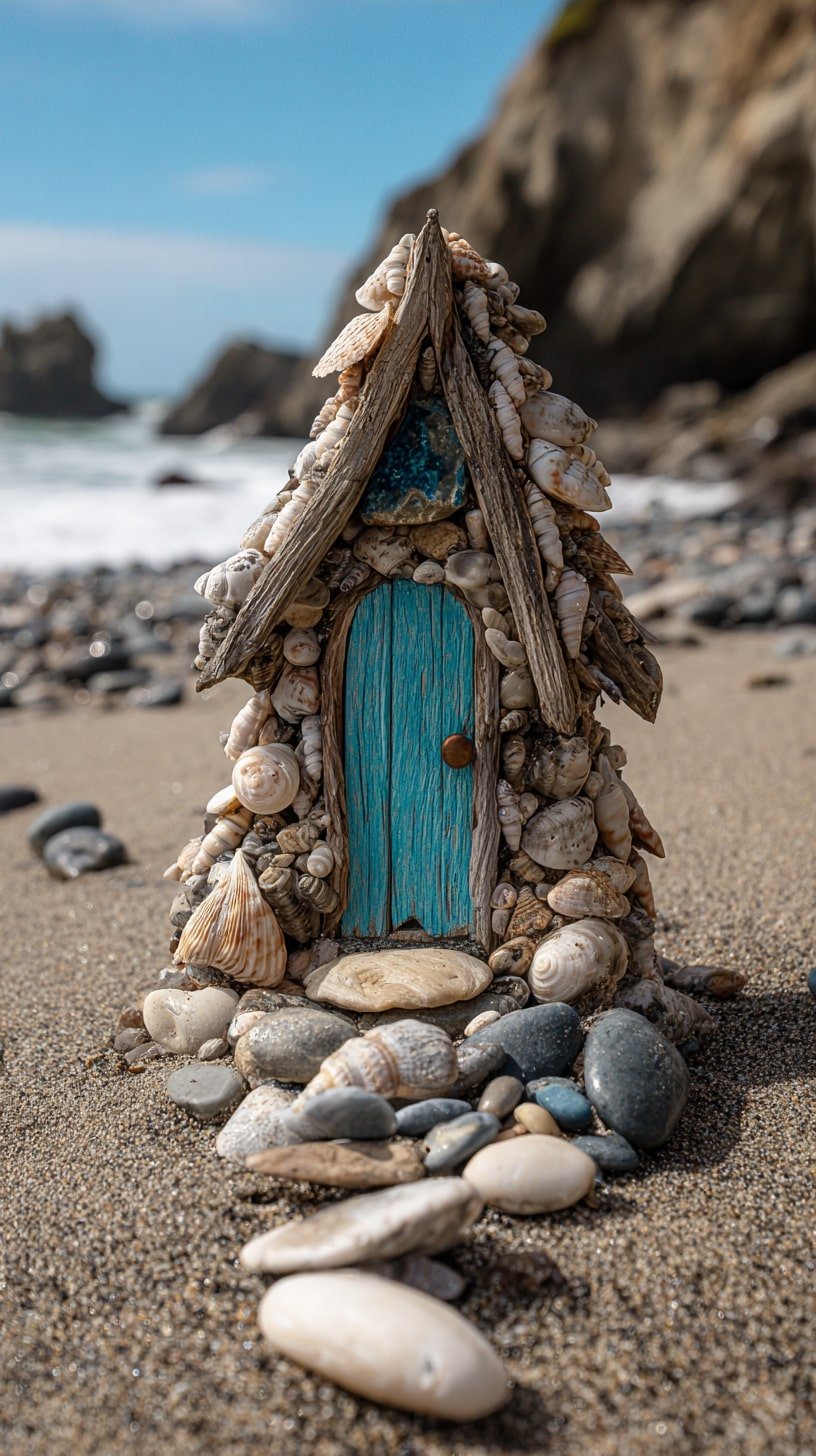
This tiny beach hut leans into found materials. Curved shell walls create volume, almost quilted.
Texture everywhere. A bold pop , that painted blue door , gives contrast, keeps it playful. Driftwood planks cap it off, forming sharp rooflines that resist beach winds.
Flat stones mimic a path, grounding it. Strong sense of place. Compact, but expressive.
7. Stack River Stones for a Soft Stairway Entry
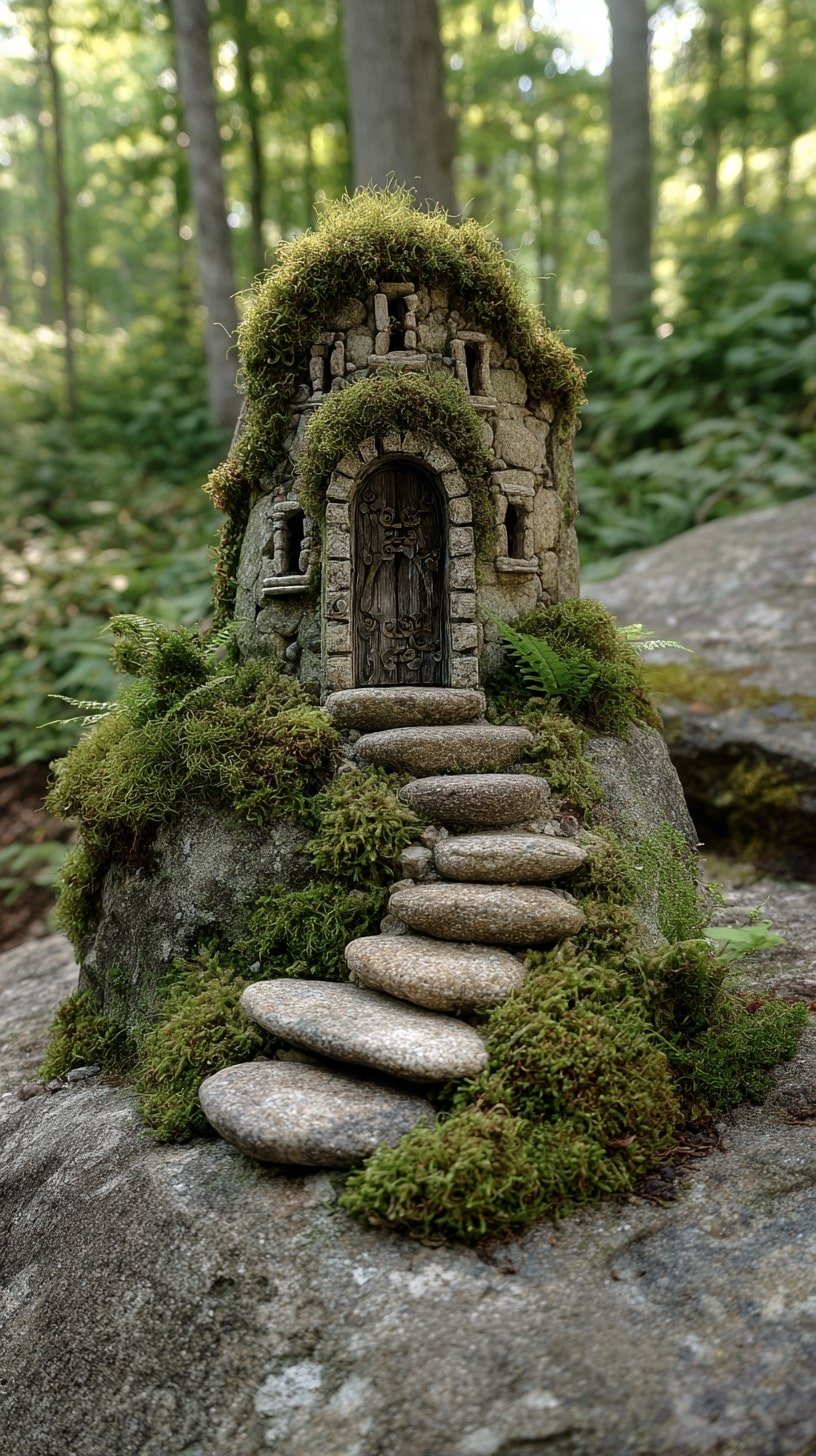
The rounded stone steps give rhythm, almost pulse-like, up toward the moss-crowned entry. Tactile and slow-paced. Texture dominates here.
Every surface, bark, lichen, split rock, holds its own shape but blends into one palette.
That aged door, carved and slightly askew, grounds the design.
8. Suspend Lanterns Over a Mossy Stone Arch
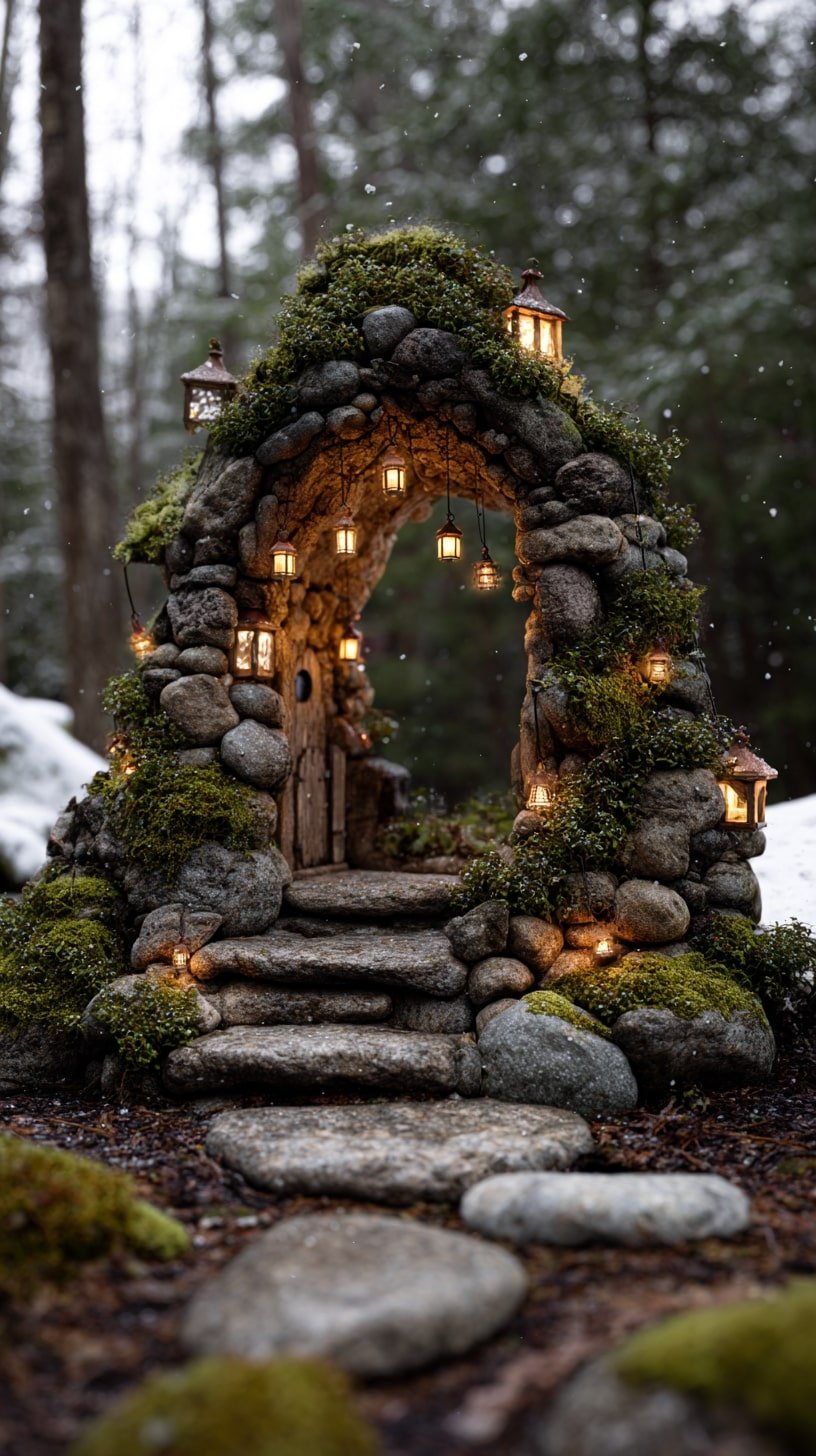
Suspended lanterns guide your eye upward while staggered fieldstones keep it grounded. The arch feels deliberate, handmade but not overly precise. Moss tucks in every seam. That detail matters. It softens the bulk. Warms the mood. Lets the structure blend into forest winter without vanishing.
9. Moss Over Curved Rooflines for a Soft Woodland Look
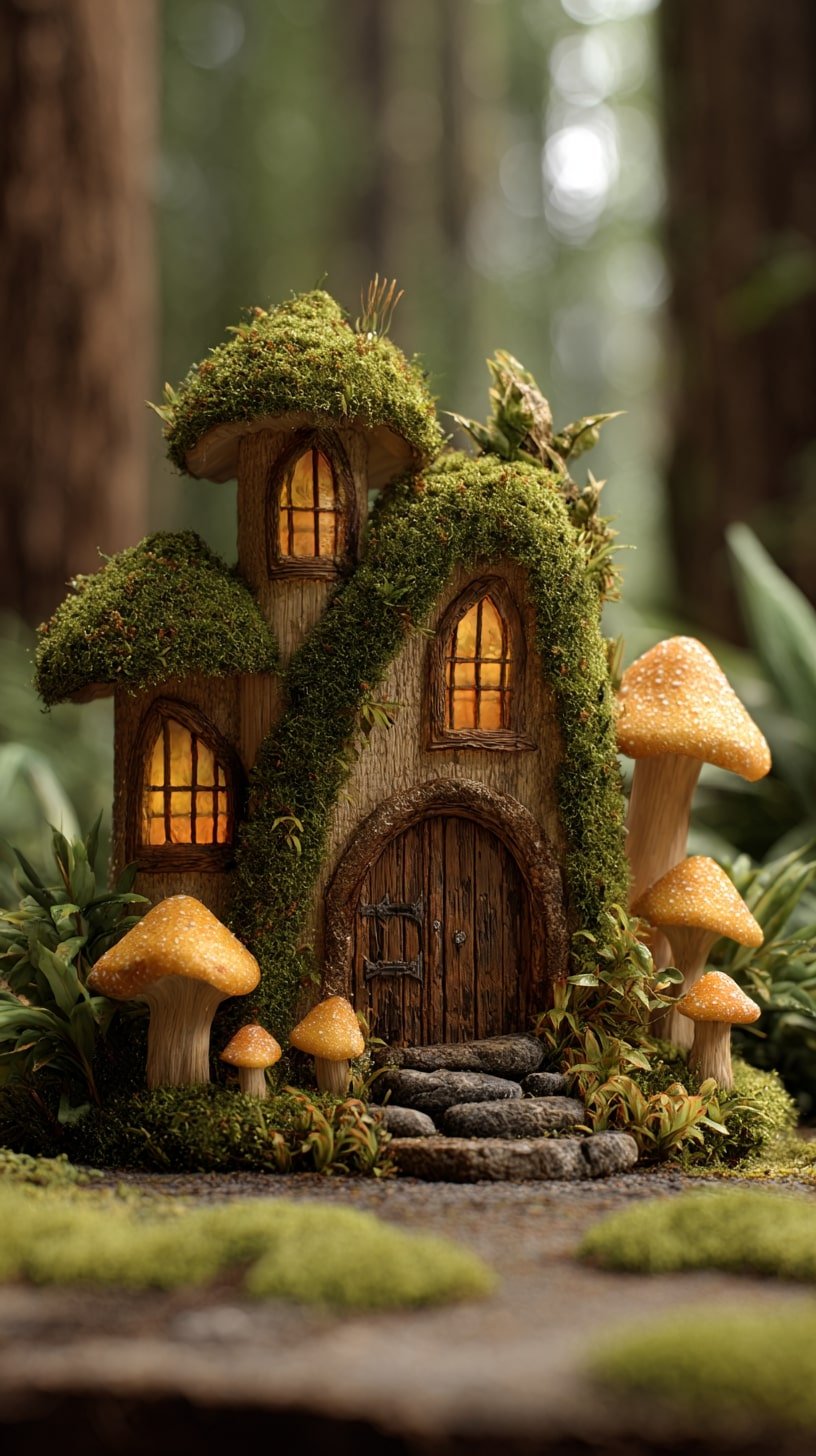
Texture drives the magic here. Each roofline is domed, almost puffed, then fully draped in moss. No symmetry, no sharp edges.
It’s rounded, irregular, believable. The staggered windows echo that softness. Clusters of golden mushrooms hug the base, bridging structure and soil.
It all reads grounded, like it grew up with the forest instead of being placed there.
10. Twisting Roofline to Echo Forest Canopy
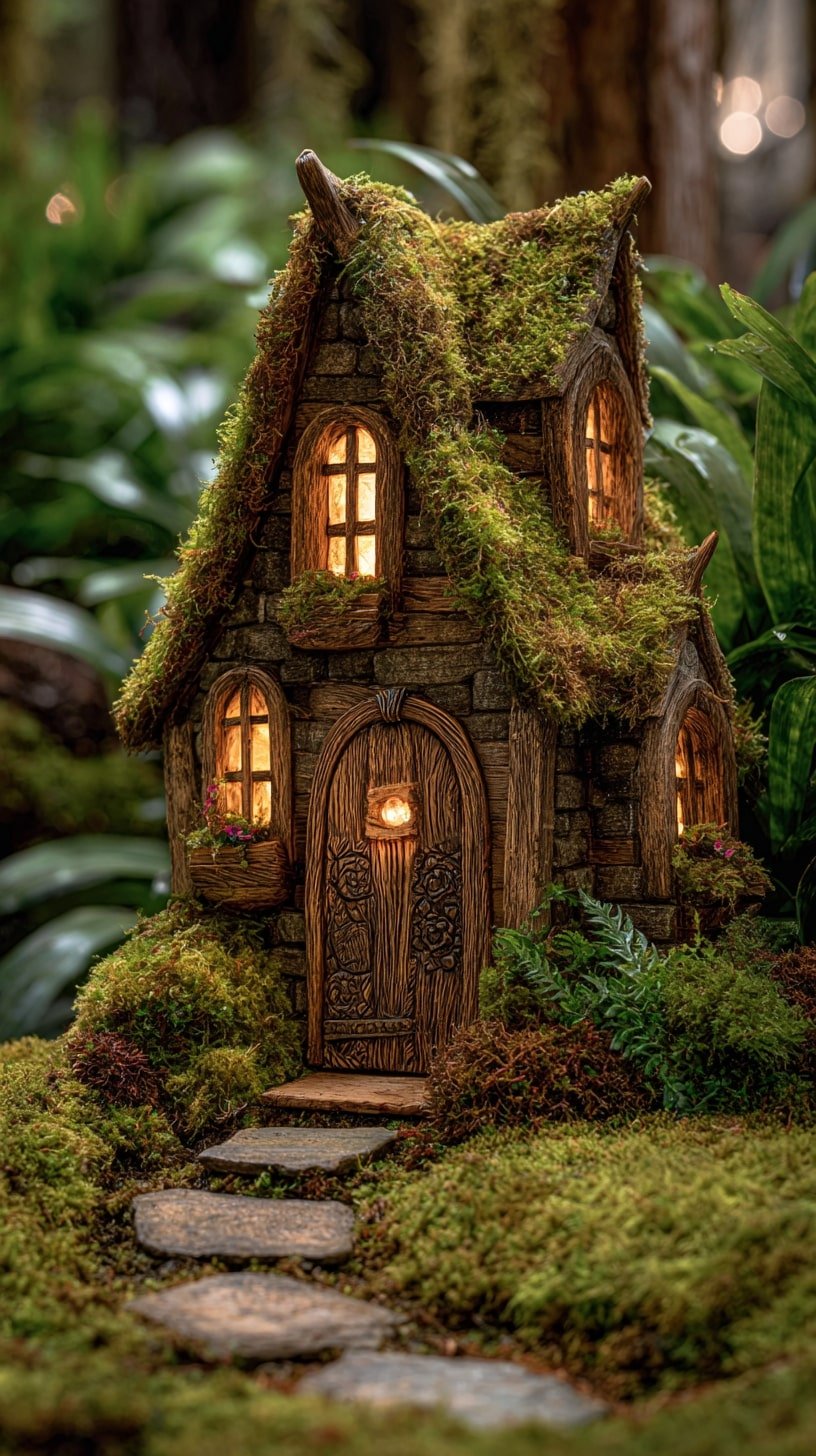
Gothic in feel, yet grounded in whimsy. The sharp, arching roofline mimics tree limbs twisting overhead. Carved door panels echo bark grain.
Window grilles nod to medieval latticework but stay soft with warm light. Moss does the heavy lifting. It fills gaps, adds softness, tames stone and timber alike.
A fairy home that feels aged, storied, maybe even sentient.
11. Living Spaces into Tree Roots for Seamless Forest Blending
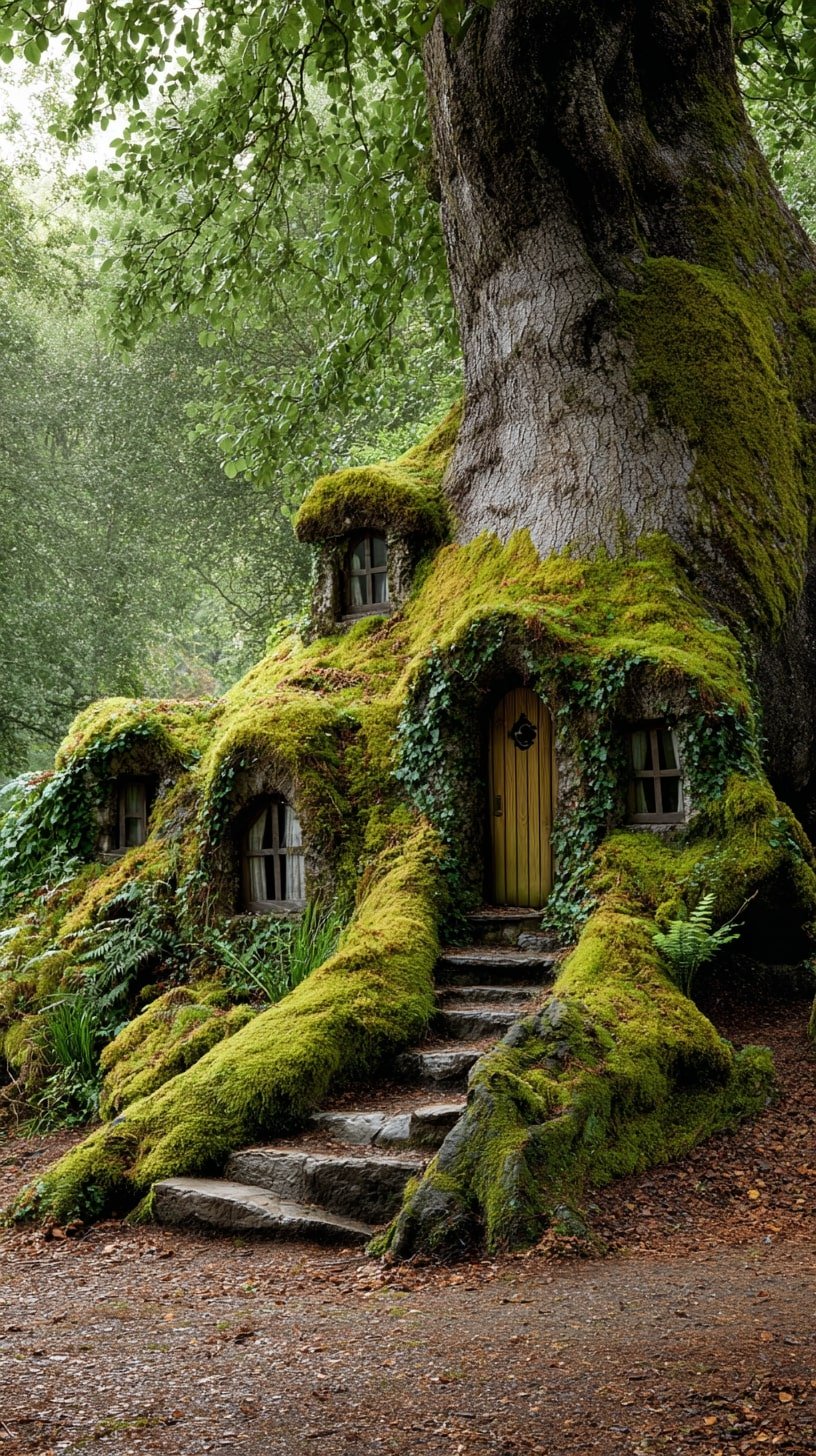
Everything flows. The house becomes the tree. Stone steps fold into mossy roots, guiding you inward.
Curved window cutouts echo hollowed wood, softened further by ivy climbing around frames. It’s more than camouflage. It’s union.
The roof isn’t built, it grows. This kind of integration reads ancient.
12. Spiral Staircase Around a Tower for Instant Storybook Drama
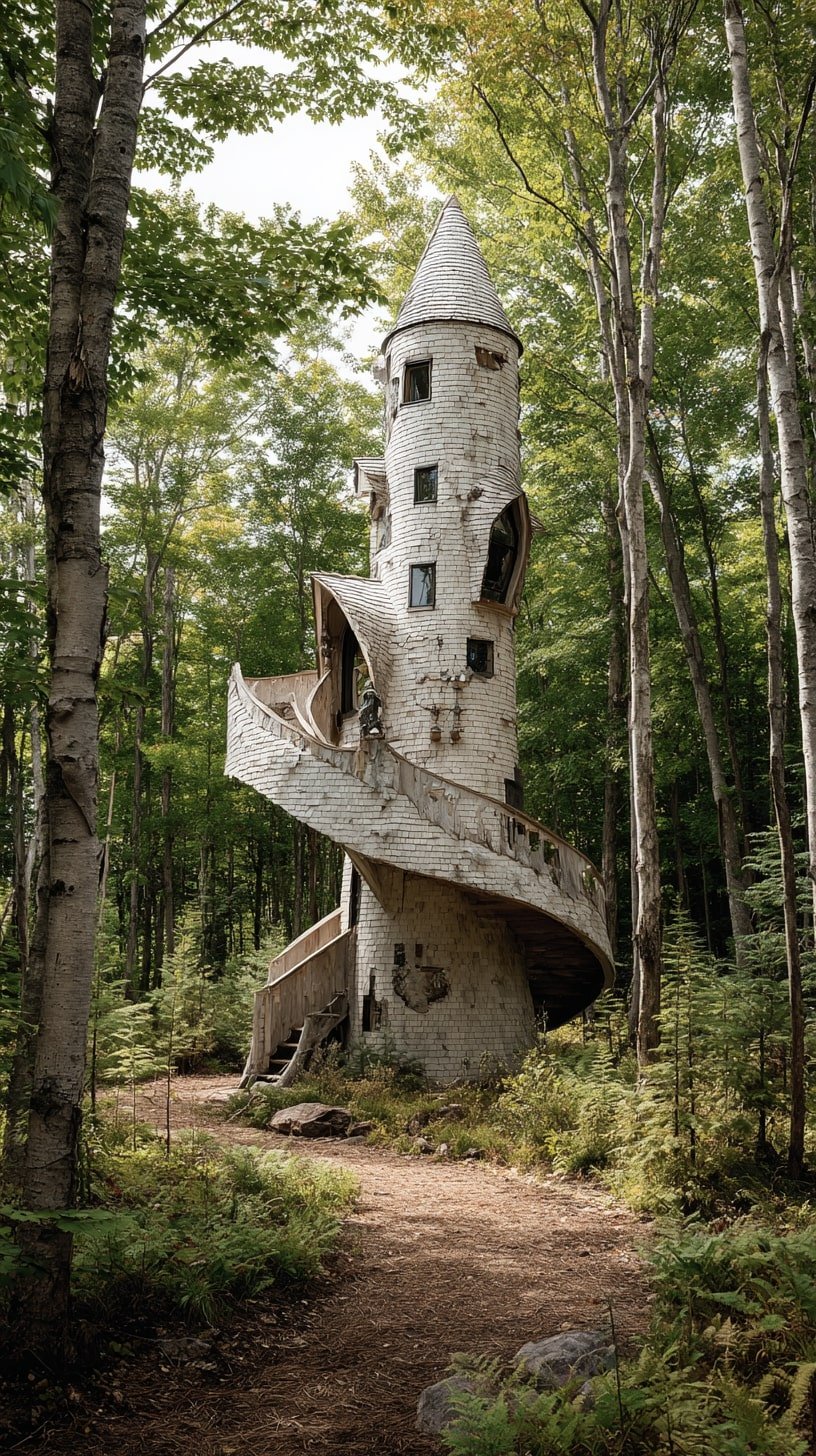
A ribbon of stair curls skyward, drawing the eye in slow motion. Weathered shingles layer like fish scales, softening the stark vertical rise.
Texture tells age. Maybe even legend. Open windows feel haphazard, but they aren’t. Each one pulls light where needed.
A design that’s whimsical, yes, but structurally thoughtful.
13. Cinnamon Sticks for Scented Seasonal Charm
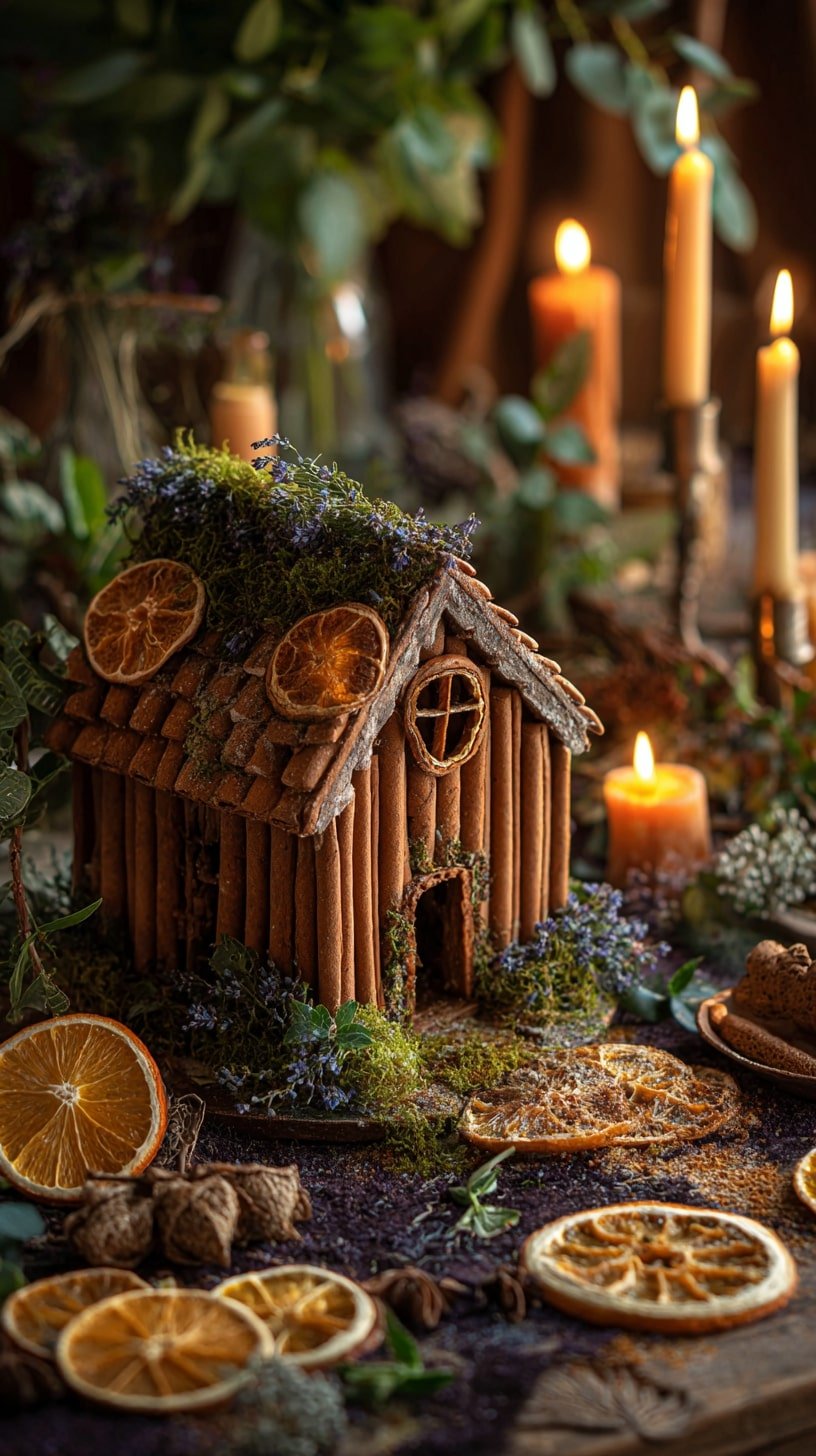
Cinnamon sticks form vertical walls, offering natural texture plus aromatic payoff. The sloped roof uses wafer-thin biscuits laid like shingles, giving rhythm without fuss.
Dried orange slices punch up contrast. Playful yet structured. Lavender and moss add softness at the base, grounding the form.
It feels edible, but holds its own as decor.
14. Stack Round Modules into a Vertical Tree-Hugging Tower
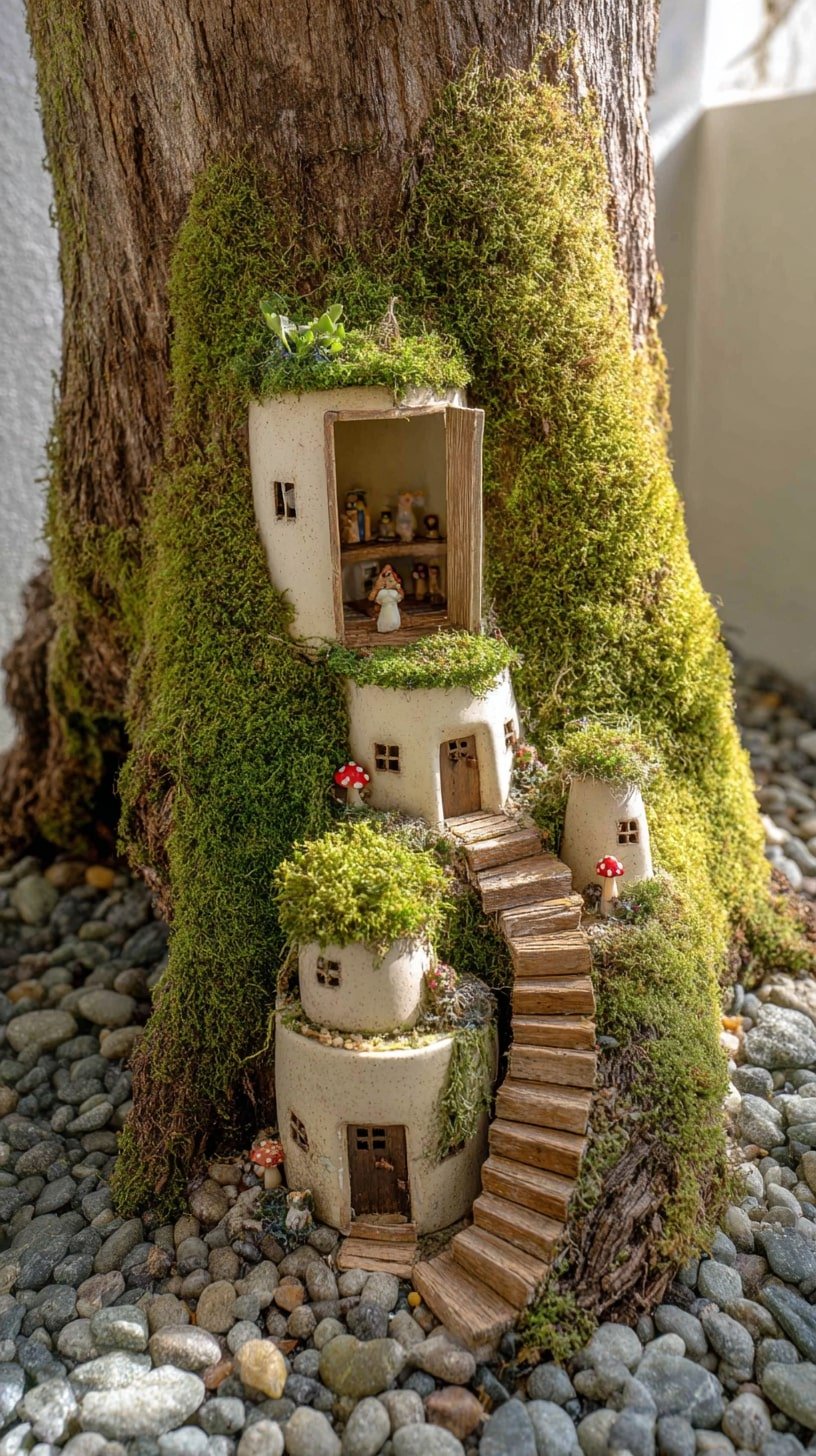
This stacked design curves with the trunk, using smooth clay cylinders and a miniature stair run to build upward without bulk.
Moss cascades down every level, softening edges. The open upper “studio” adds story. Like a dollhouse, but built into bark. Rounded doorframes, micro mushrooms, and pebbled ground keep it nestled in nature.
15. Wooden Door into a Mossy Tree Base
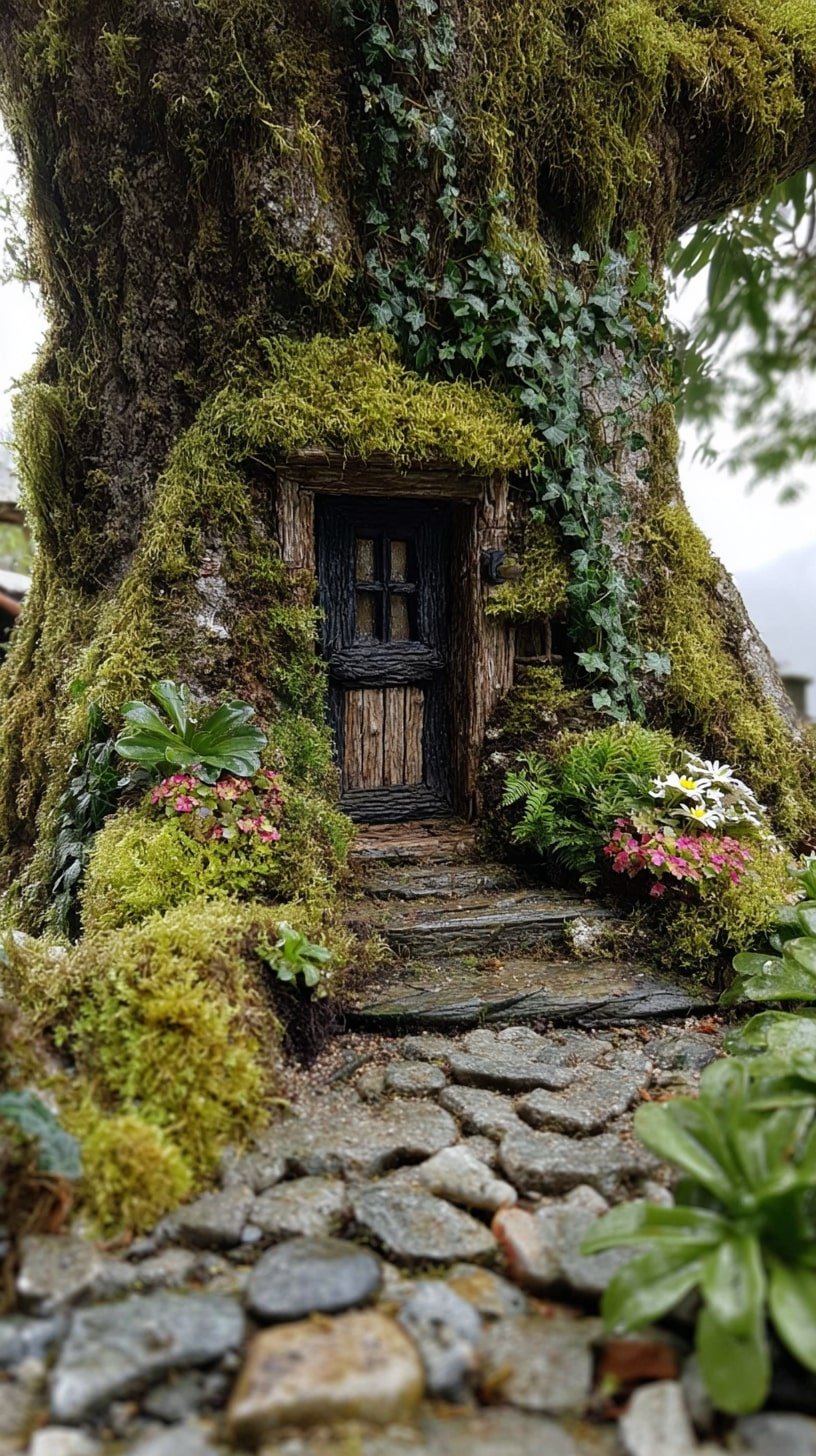
This design leans hard into realism, embedding a rough-hewn door flush with bark. Dark wood contrasts sharply against the vivid green moss.
Ivy creeps upward. Stone steps settle into roots naturally, and the plantings are smart, low blooms like impatiens and daisies keep scale believable.
No gimmicks. Just smart, quiet placement.
16. Pumpkin Shell for a Glowing Woodland Scene
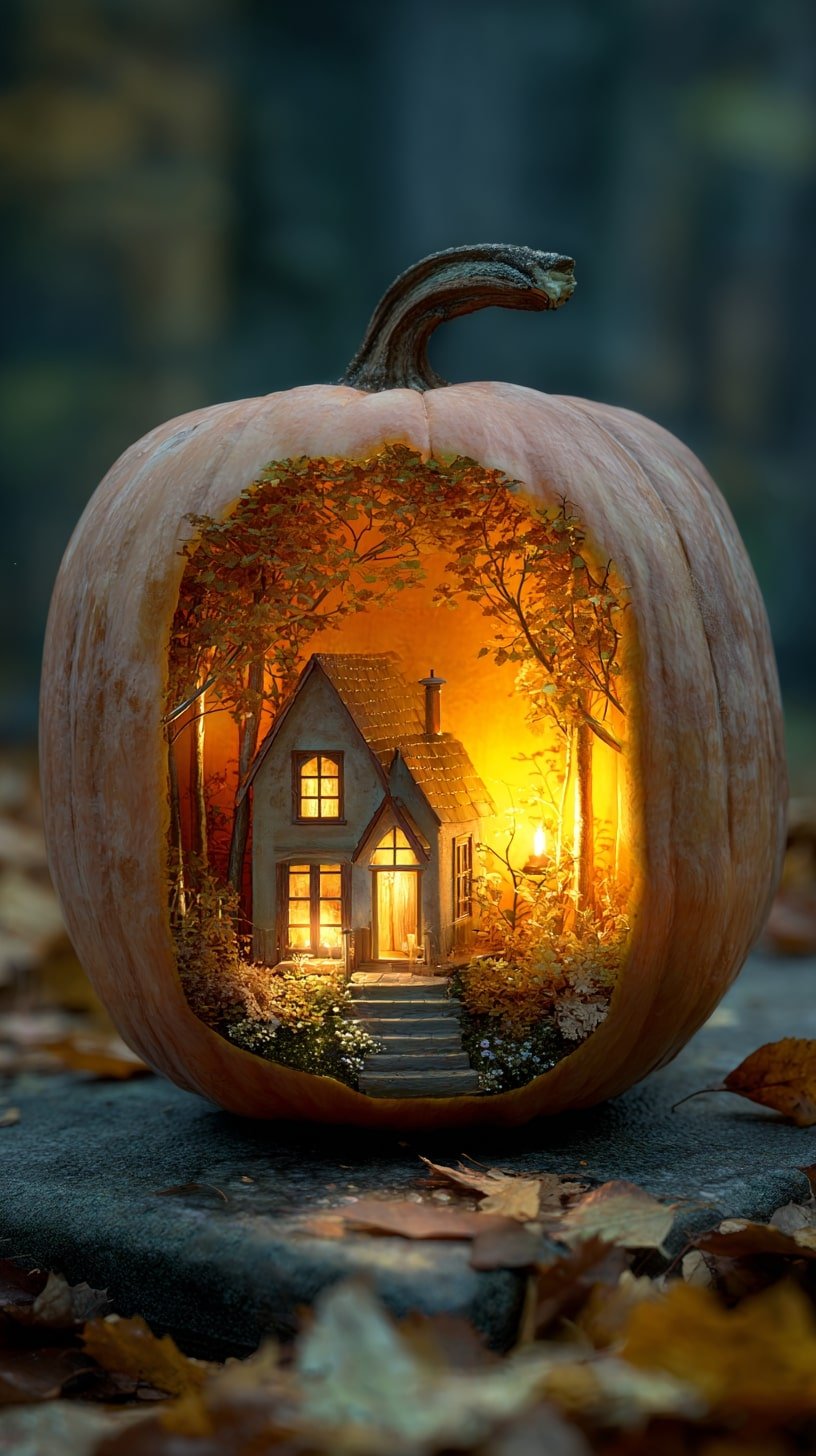
A carved pumpkin becomes both container and spotlight, casting warm light onto a tiny forest vignette.
Structure feels balanced, steep-gabled roof, centered door, layered shrubbery. Sharp lines anchor it, while soft backlighting pulls everything forward.
Look closer, tiny trees echo the pumpkin’s curve. Lighting defines mood.
17. Burlap Sheets for an Earthy Tent-Style Hideaway
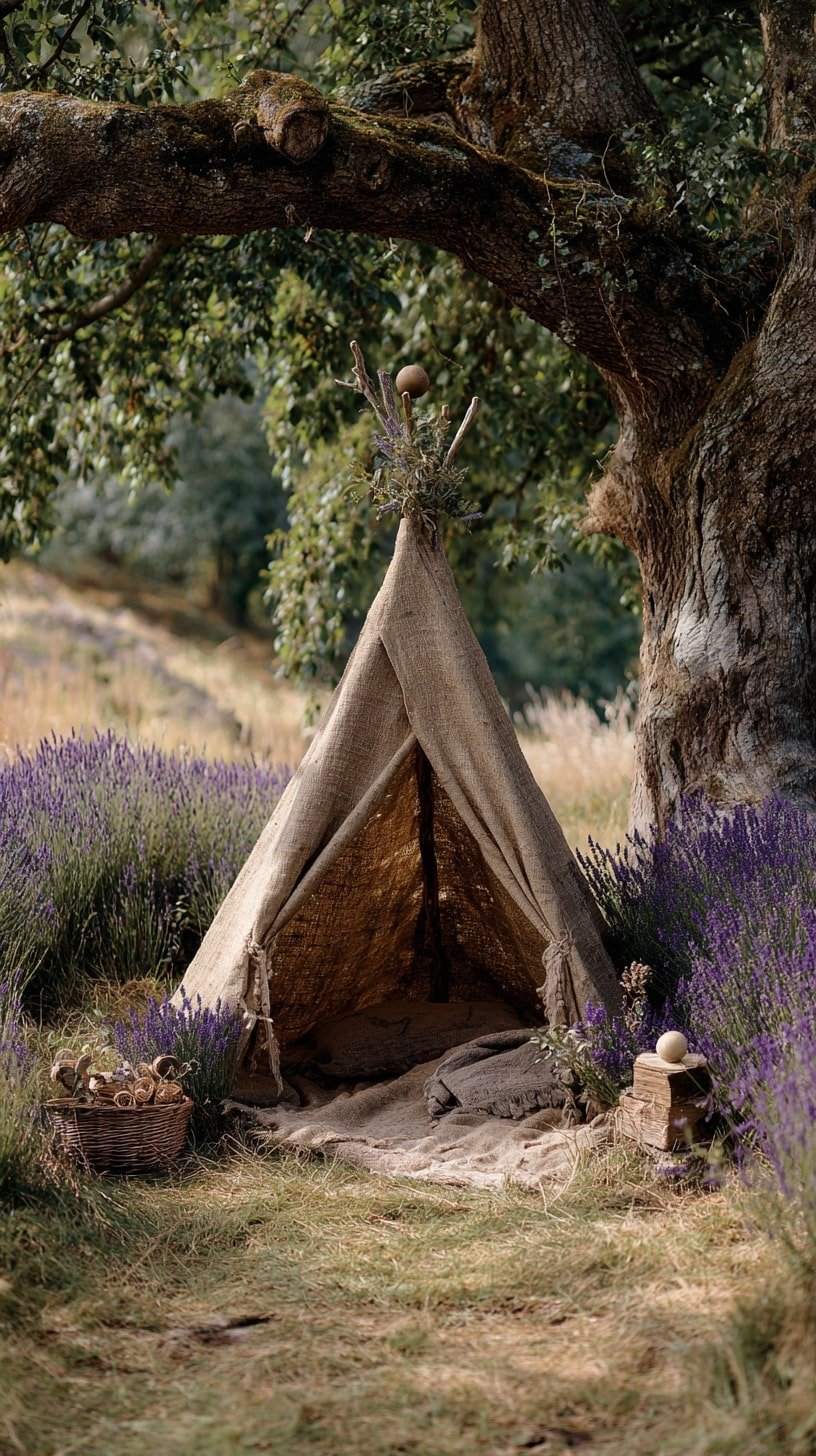
Burlap brings raw texture and organic tone, blending into the tree’s weathered bark and lavender’s soft spikes.
Structure’s simple, just two poles and twine, but the setting does the rest. Nestled under heavy branches, framed by wild blooms, it feels tucked away.
Little details lift it. Rolled scrolls in a basket. Pebbled path, barely cleared.
18. Fall Leaves over Rooflines for Seasonal Charm
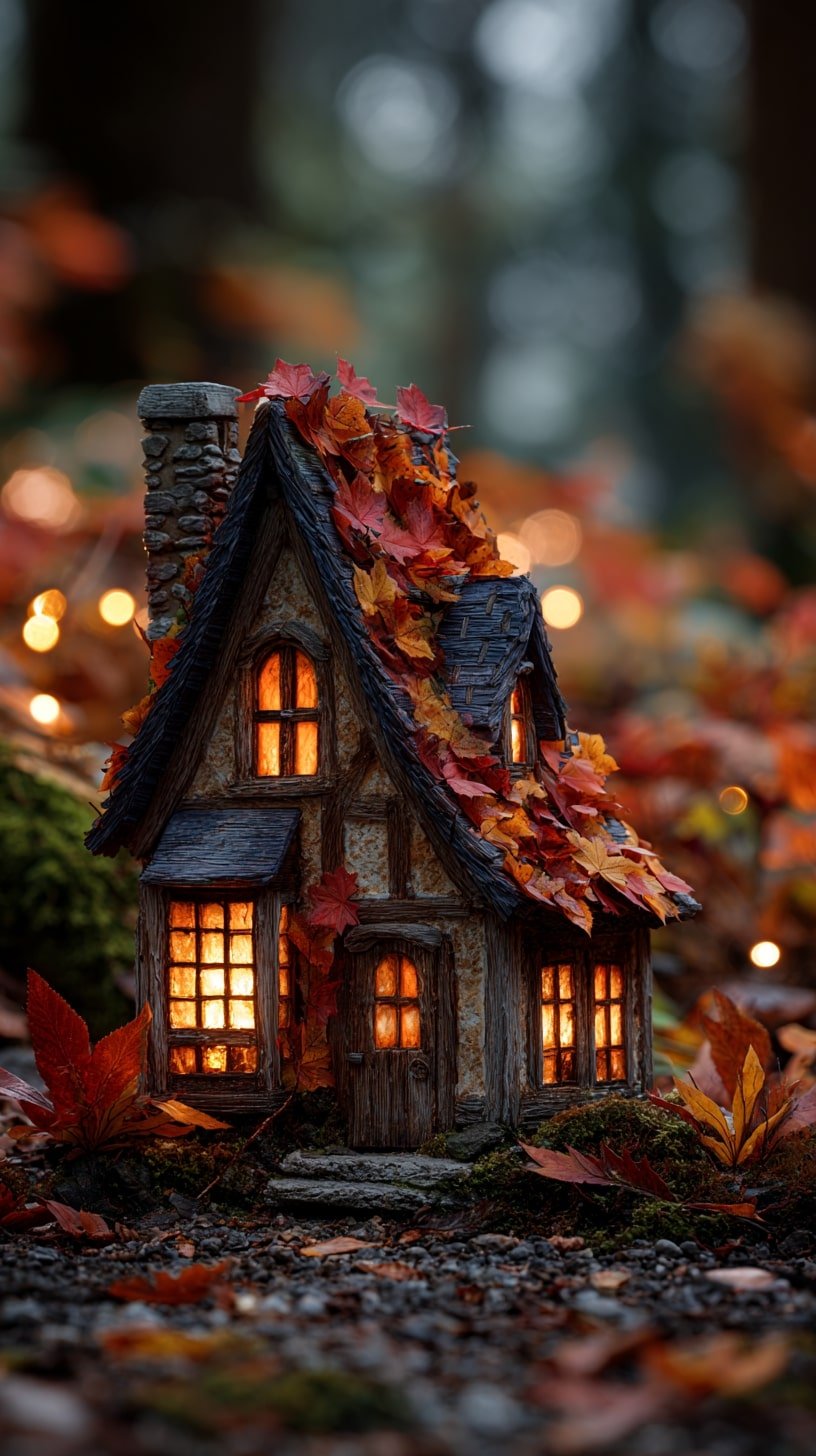
Dried maple leaves tucked along the roof add a warm, fleeting texture. They drape like natural shingles, softening edges with a blaze of amber and crimson.
Light glows inside. It feels lived in, protected. Frame’s tight and vertical, with high gables and narrow windows. Cottage scale.
Chimney adds heft. Set low into moss, the house feels anchored.
19. Walnut Shell as a Fairy Cradle or Offering Bowl
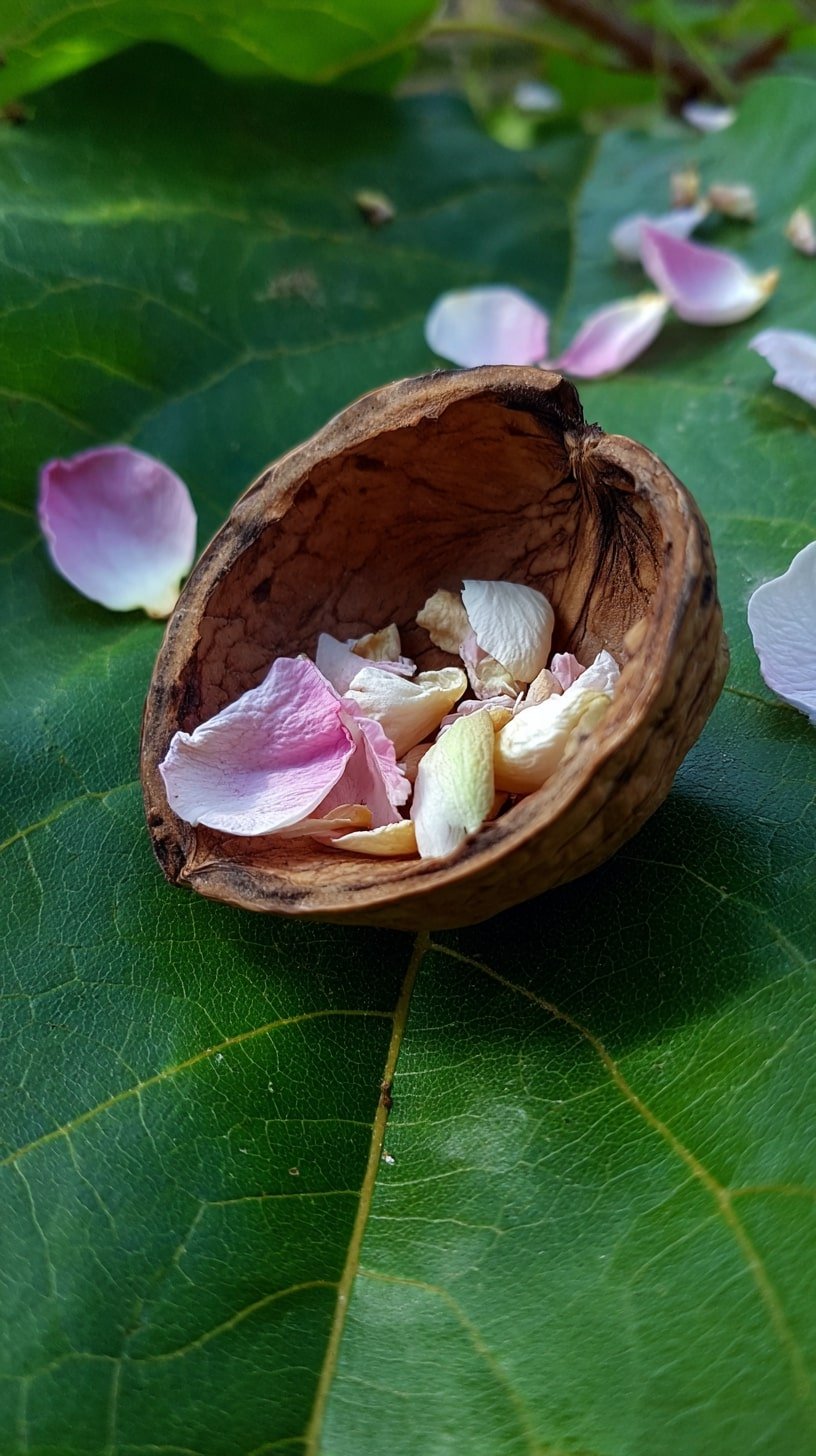
A halved walnut shell becomes a rustic basin, petals, seed husks, or fairy bedding. It reads organic, delicate. Cracked edges feel natural, aged. Placement matters.
Nestled on a leaf, it blends into the landscape. Almost disappears. Pink and cream petals break the brown, drawing the eye. Whimsy meets compostable craft.
20. Pine Scales for a Textured Tower Look
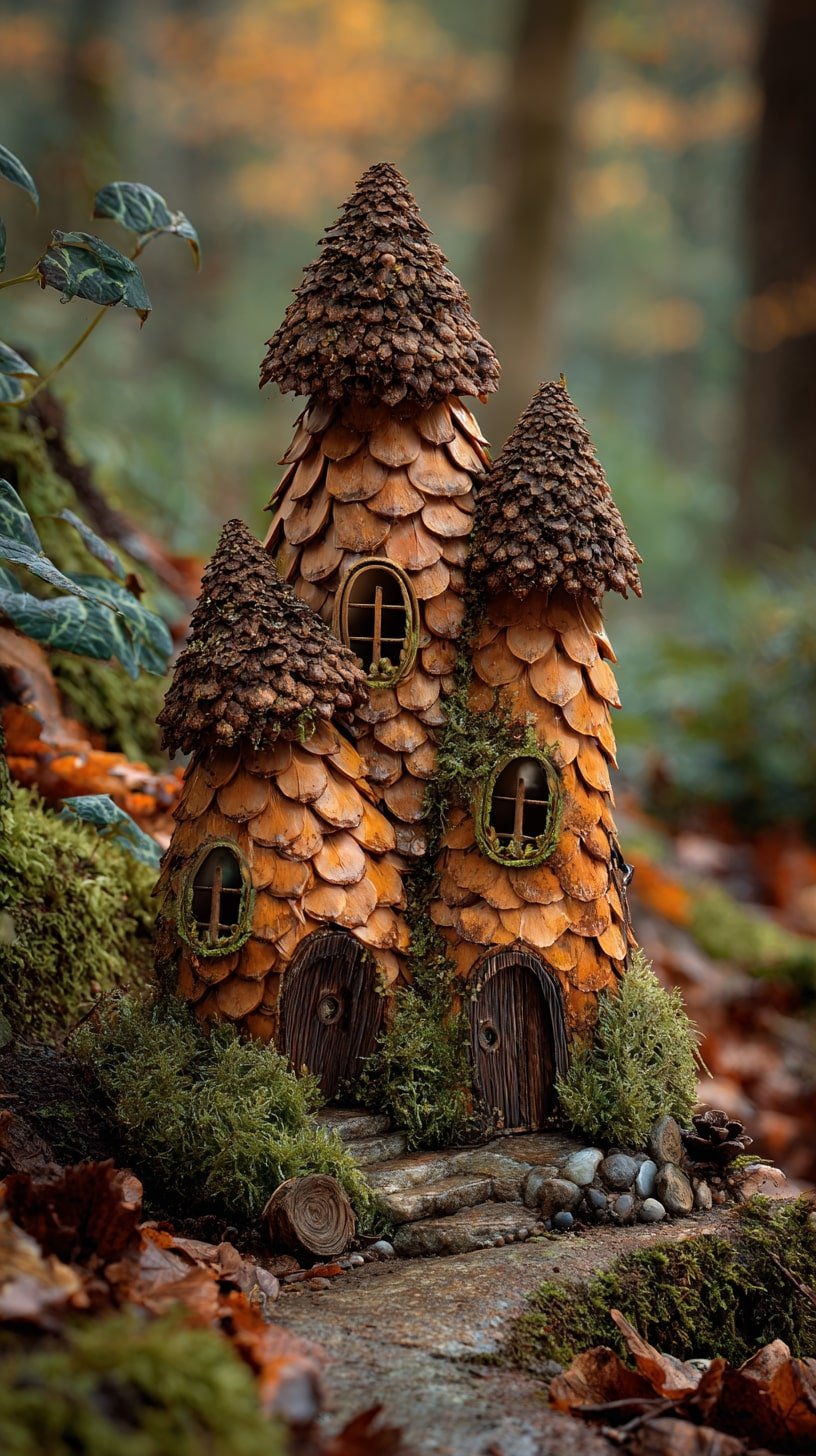
That’s what gives this house its fairytale rhythm. Each turret rises with scale-like cladding, made entirely from pinecone petals.
Overlapping texture adds warmth, almost shingled. Windows stay arched, small, nested into curved walls.
Three entries, each framed by bark and moss, suggest a shared home, maybe even communal.
21. Roofline in Moss for Whimsy and Warmth

Soft greens drape every corner. Moss gives texture, shape, and age, like the house grew into place.
Look at how it curves under window sills, spills between lantern lights. Framing stays rounded.
Arches at the door, high-pitched rooflines, even circular windows. Candles cluster at the threshold, not just for glow but ceremony.
22. Mossy Hilltop with Draped Curtains in a Teacup Base
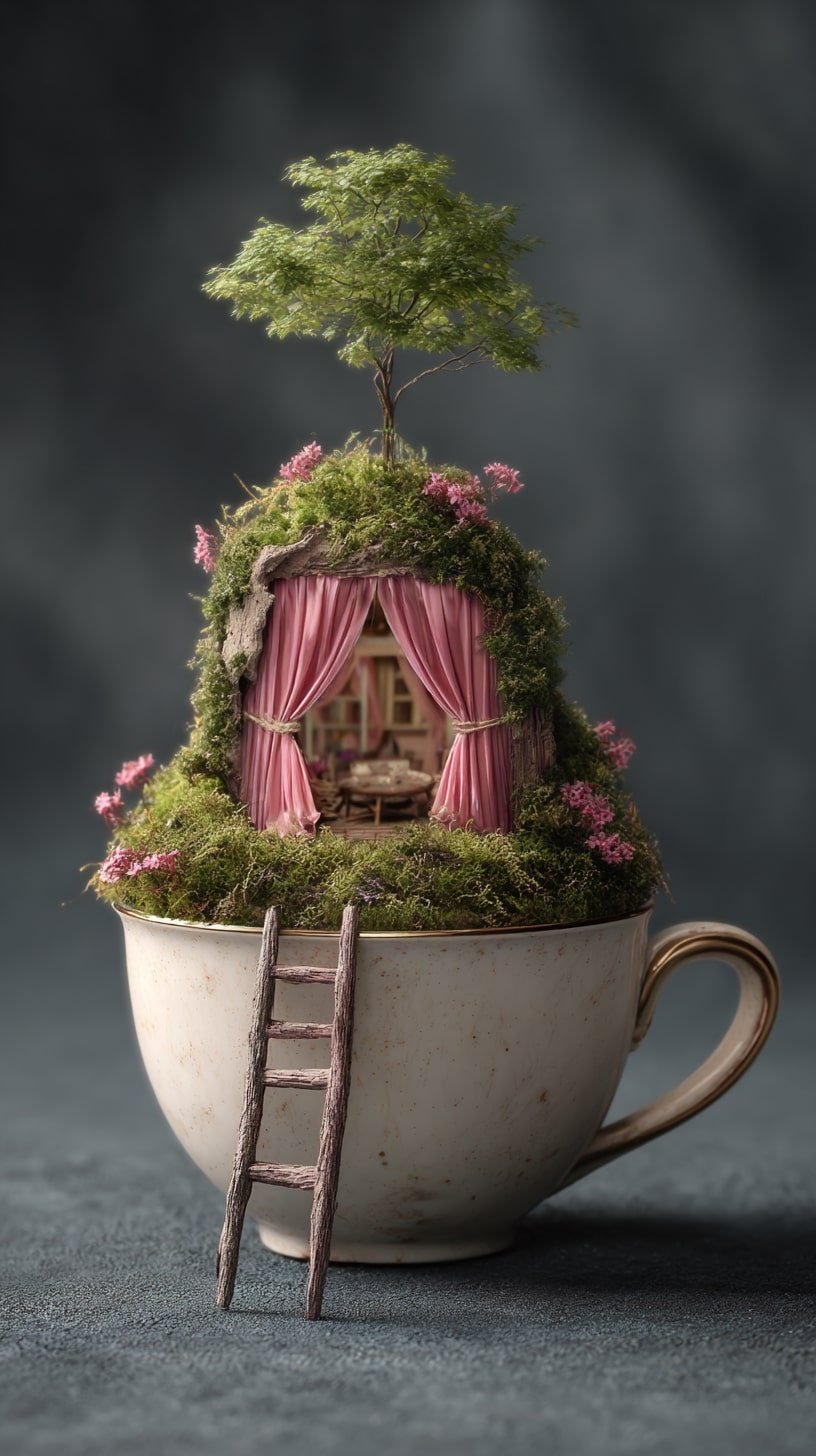
A single cup becomes foundation. That’s bold scale play , using a dainty item to support full story-building. The bark-trimmed window feels carved, not placed. Soft pink curtains break up green textures, drawing the eye. Strong vertical lift from the tree adds height contrast. Balanced, but cheeky.
23. Blooming Entryway with a Glass-Topped Mini Greenhouse
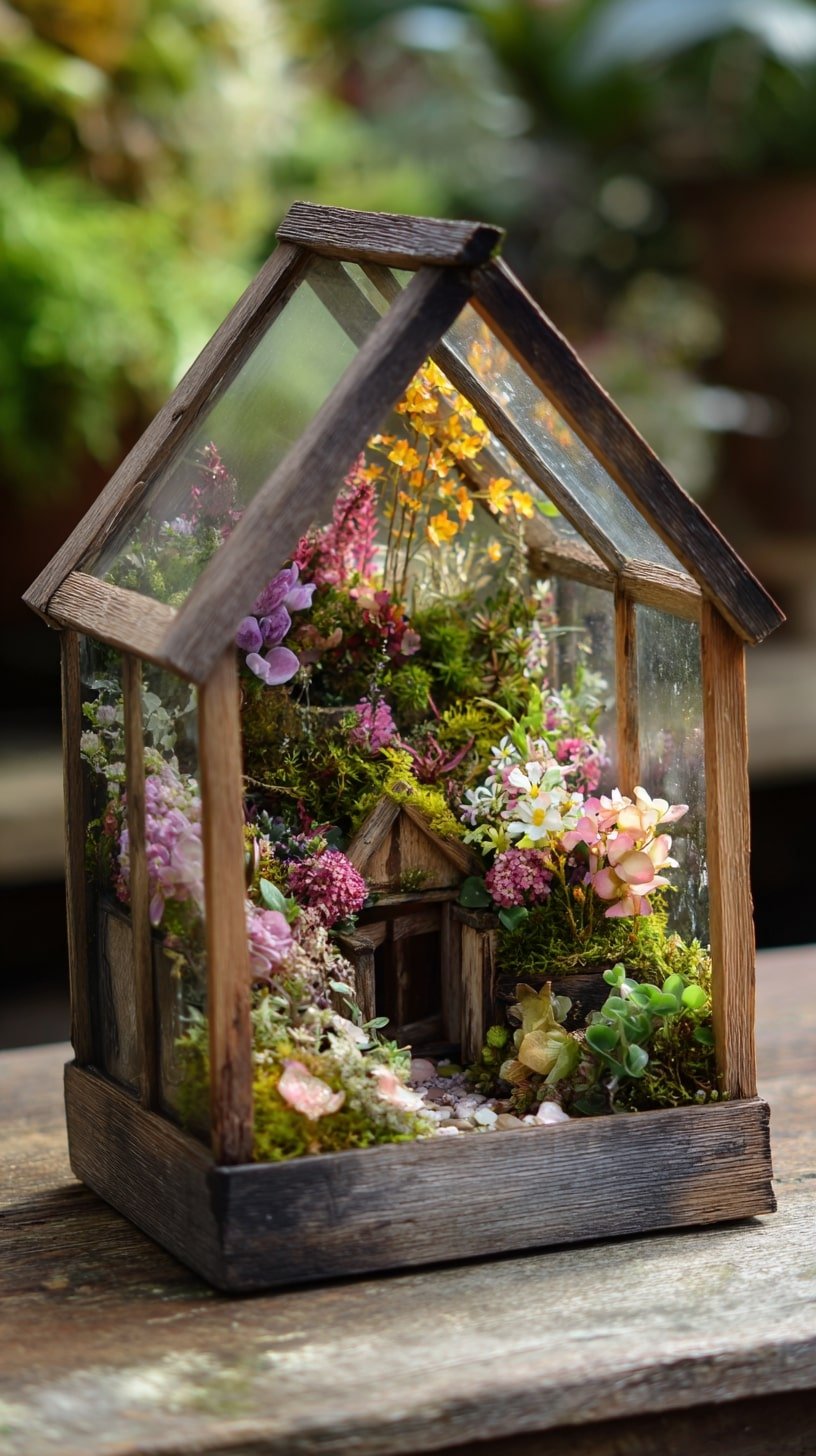
That’s the beauty here. A rough-edged wood frame feels weathered, grounded. Transparent walls expand light, while sealing in structure.
Inside, color explodes. Layered blooms, moss cushions, pops of yellow and violet. Even the path, pink pebbles, softens the grid. Scale’s tight but never cramped.
A lush micro-ecosystem built for wonder.
24. Out a Table Nook with Mossy Stone and Miniature Wood
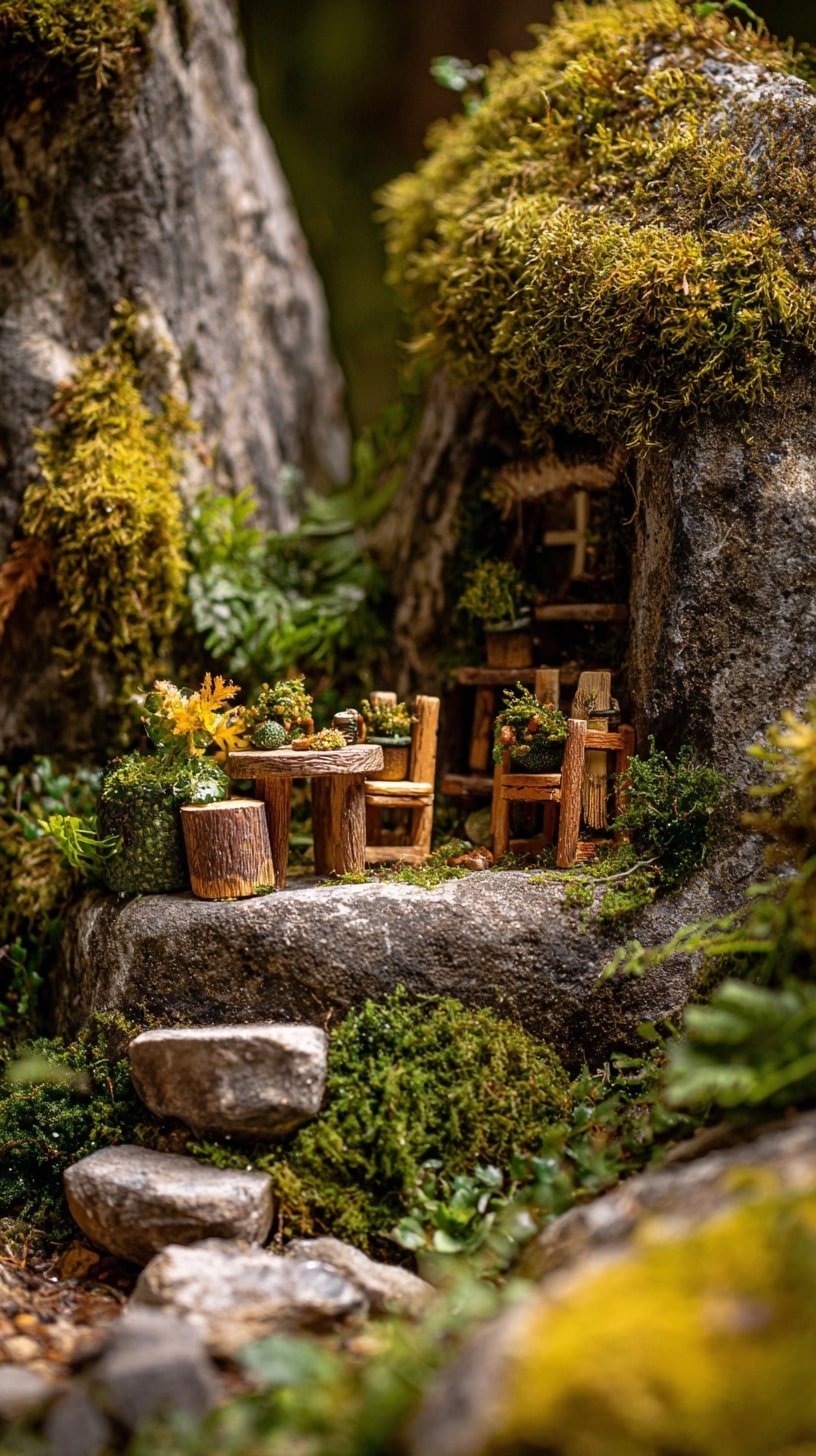
Natural boulders create both enclosure and elevation, cradling the scene like a hidden retreat. Tuck in a round wood table, uneven legs and all. Add stump stools, crooked chairs. Imperfect feels right. Texture-rich moss blends vertical and flat surfaces, softening edges, cooling color.
25. Hollow Out a Coconut Shell for a Coastal Fairy Hideaway
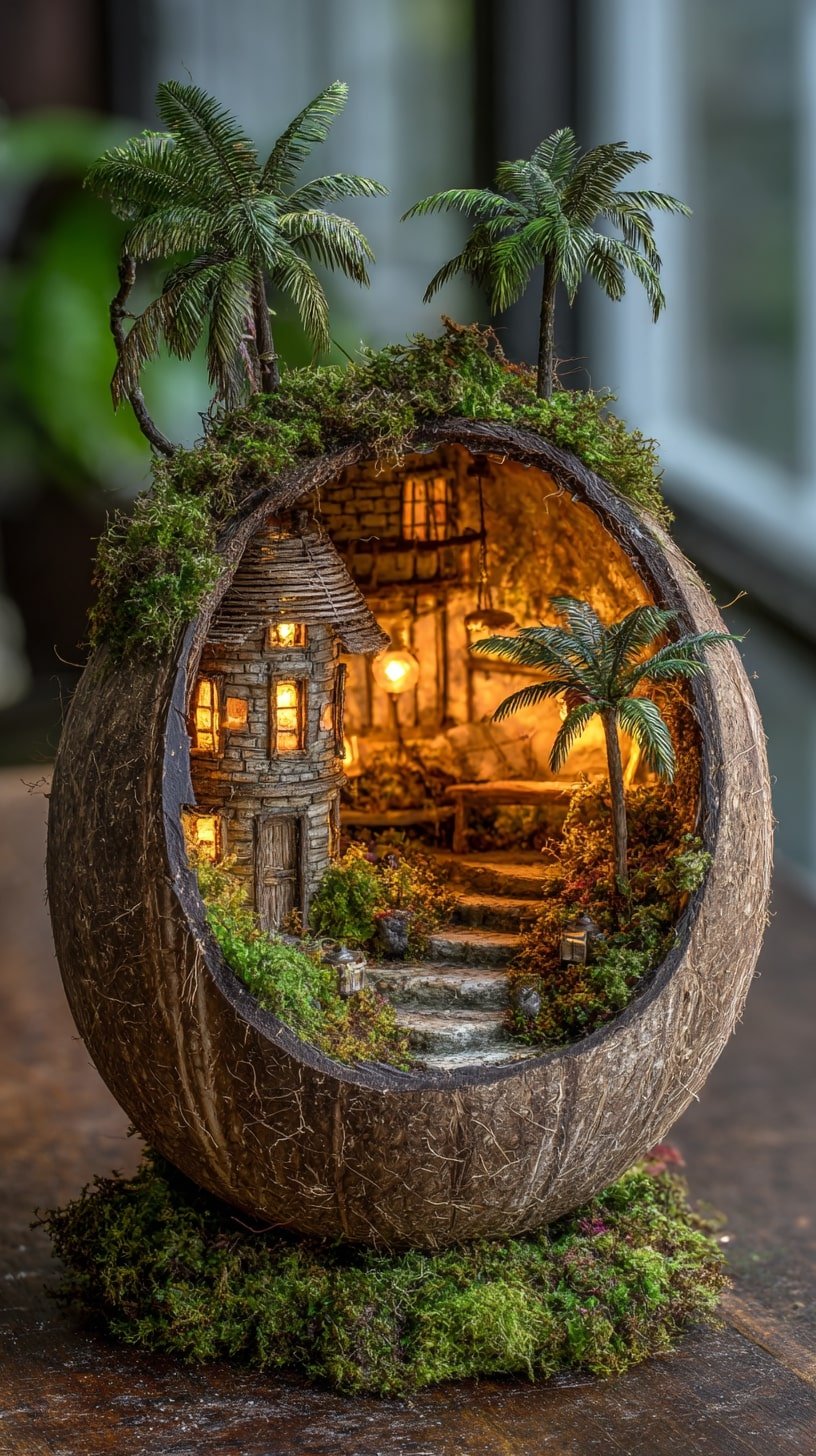
Carved coconut acts as both shell and showcase, its rough texture playing off warm interior light. Add a tiered stone path. Curve it deep into the base. Nestle a turreted cottage tight into the back wall. Then, go vertical, tiny palm trees break the sphere’s boundary
26. River Pebbles and Flower Beds to Frame a Fairy Front Walk
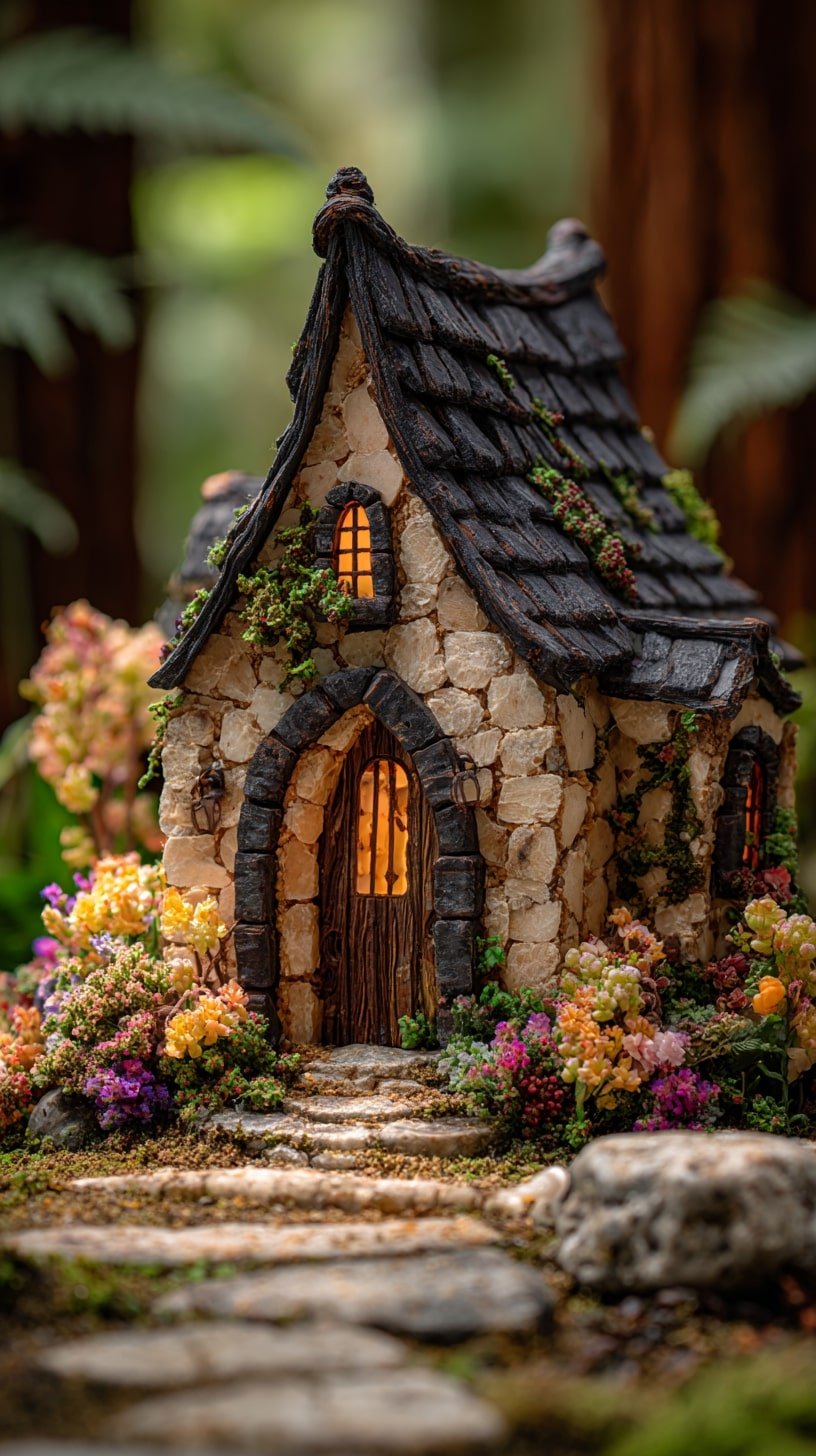
A stone path leads right to a hand-carved wooden door, framed tight with charcoal grout and golden mortar.
Every edge softens, no hard cuts, no symmetry. The walls, made of chunky pale rock, contrast that dark shingle roof. Clustered blooms wrap both sides.
Dense, low-growing. Saturated pinks and yellows punch through mossy green. Just enough whimsy.
27. Stagger Bright Hues Across Narrow
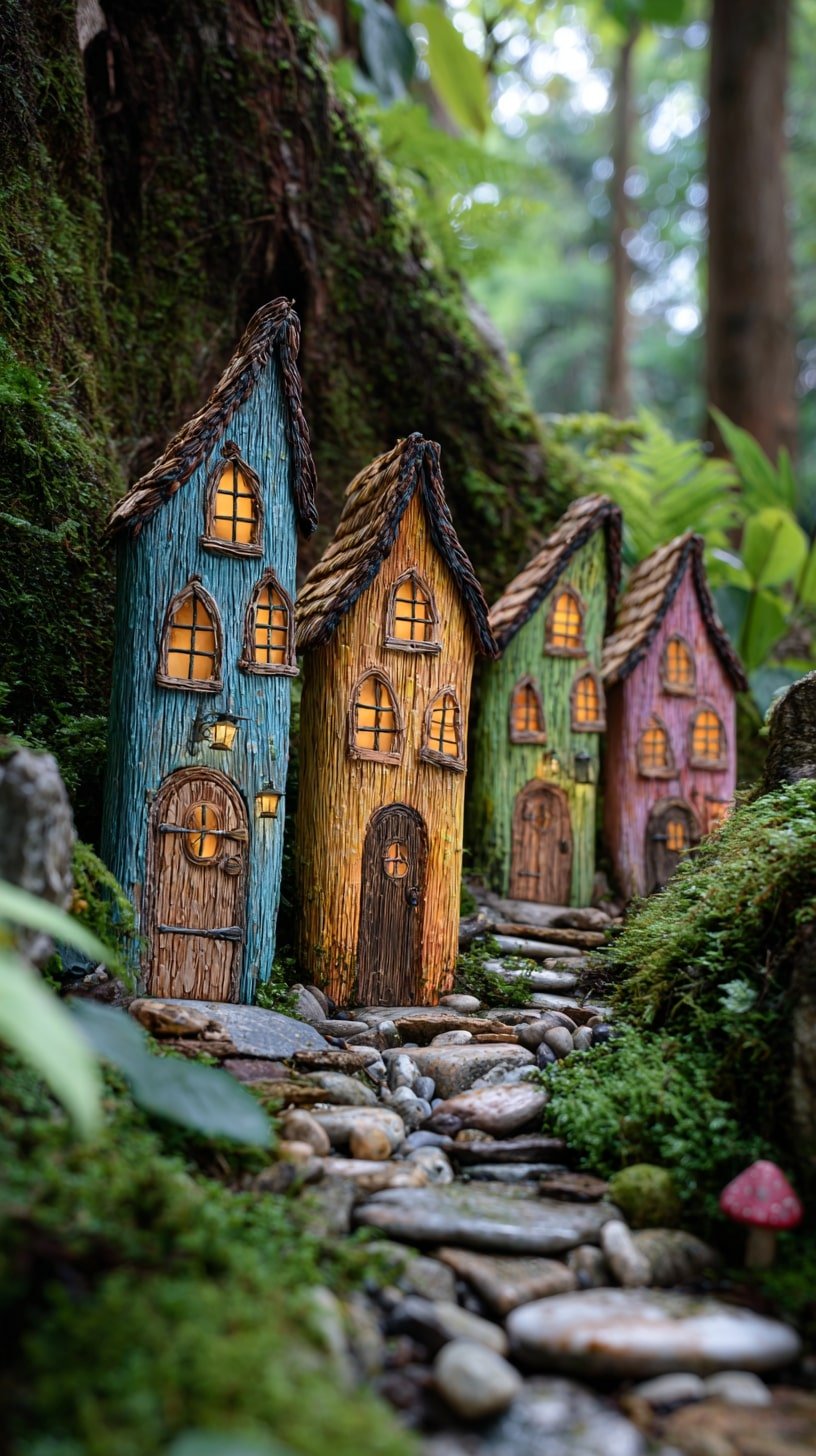
These tall, slim cottages lean slightly off-axis, which creates charm without clutter. Texture matters, grooved façades mimic wood grain but carry color boldly.
Go bright. Think ochre, teal, coral, moss. Each unit repeats core shape, arched doors, latticed windows, but tweaks their placement just enough.
A curved pebble path grounds the energy.
28. Window Arches into a Pumpkin Shell for a Glowing Woodland Look
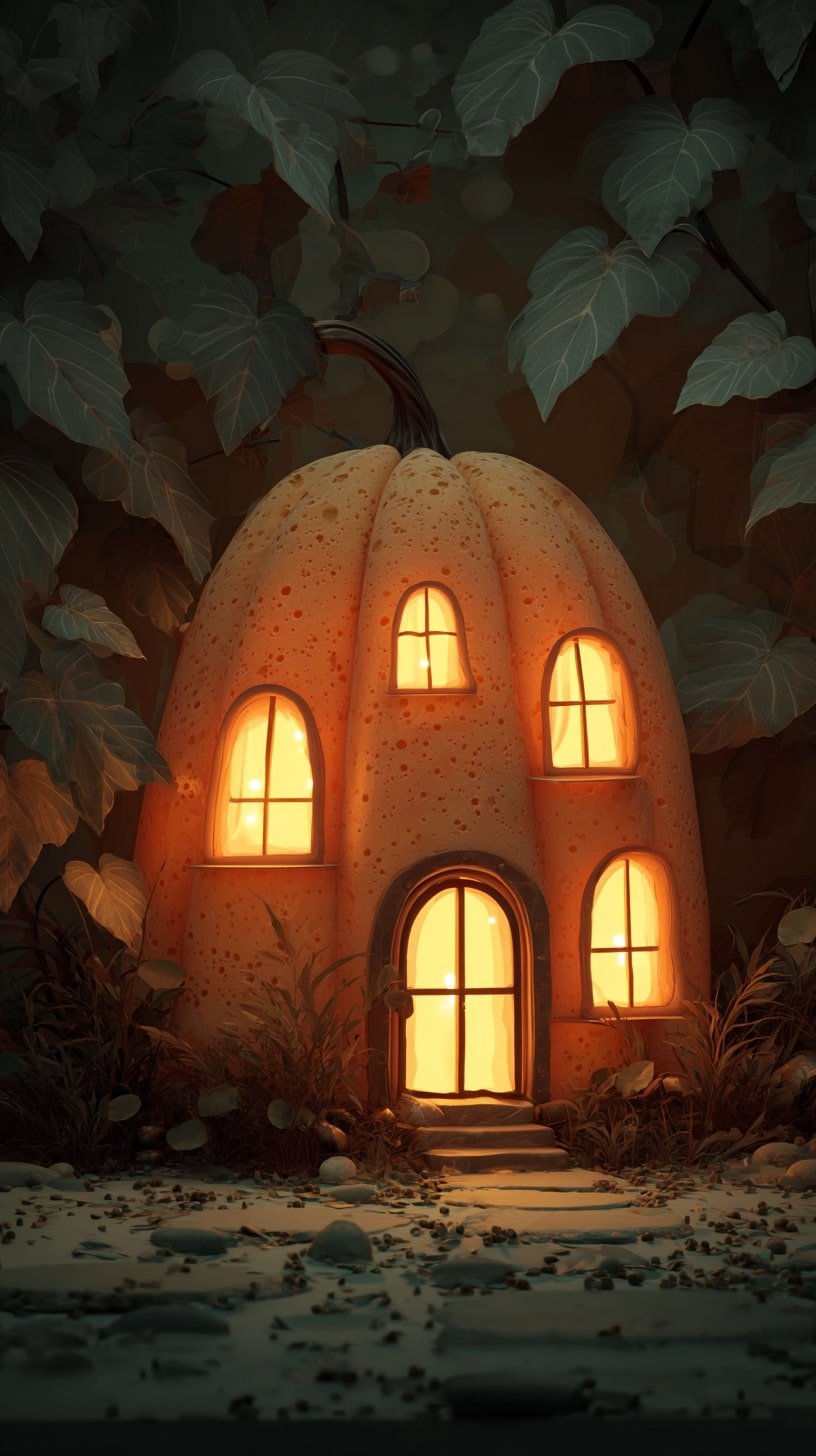
Form meets fantasy. Sculpted from a single gourd, the structure leans into natural curves, no added flourishes. Just a soft orange tone, speckled for realism.
Arched windows glow evenly, placed in a staggered grid for balance. Steps barely rise above moss, blending entryway into earth.
It’s compact, contained, quietly magical.
29. Stone Pod and Line with Moss for a Forest Sanctuary Glow
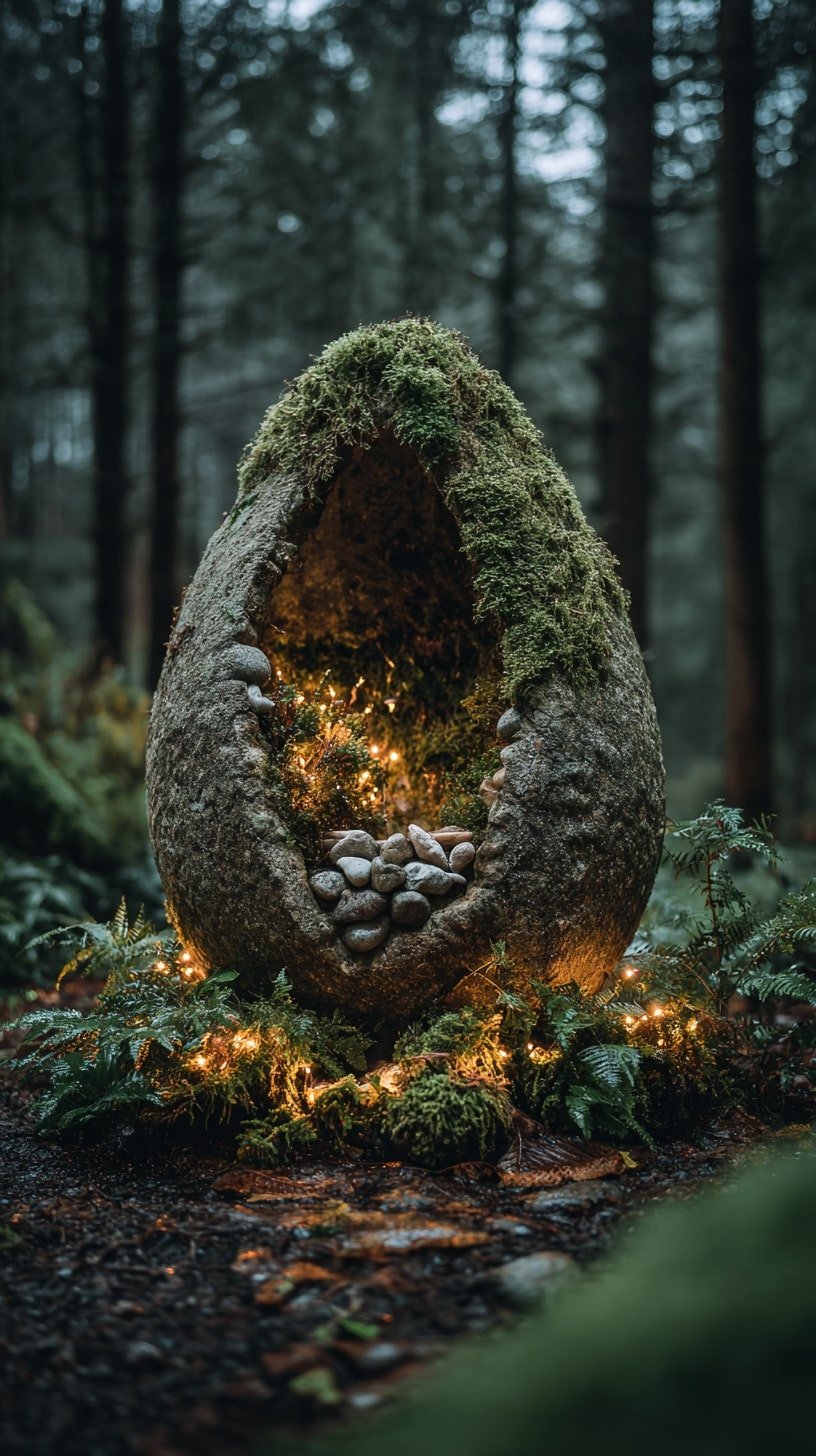
The split pod form feels ancient, like it cracked open by time. Thick moss crowns the top, trailing into the hollow where gravel anchors the floor.
Tiny lights thread through ferns and crevices, barely visible yet wholly present. No sharp edges.
No flat planes. Everything curves, clings, breathes. Feels hidden but deliberate.
